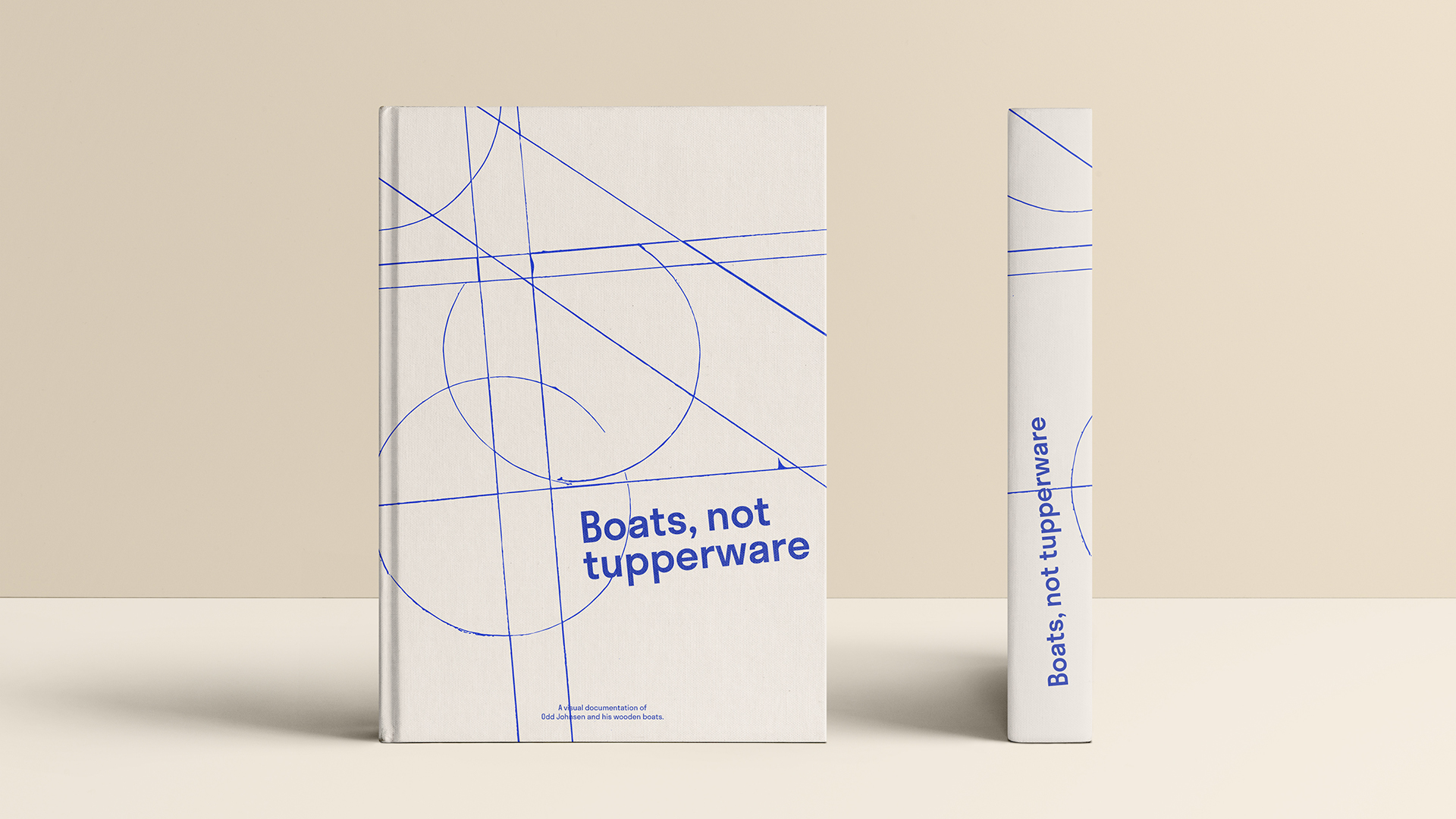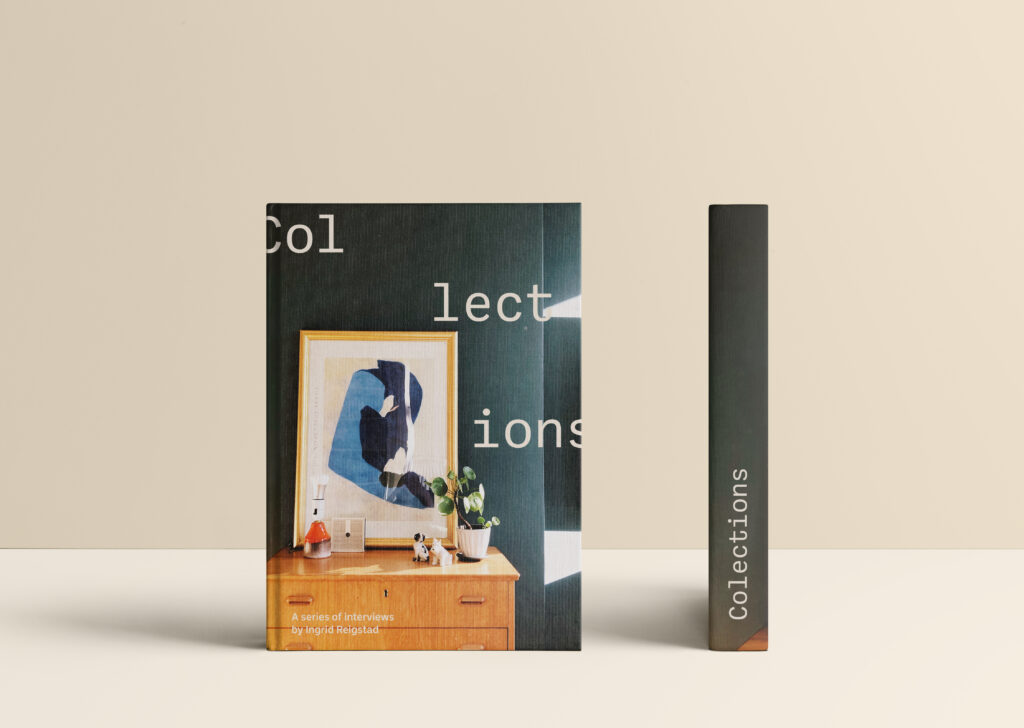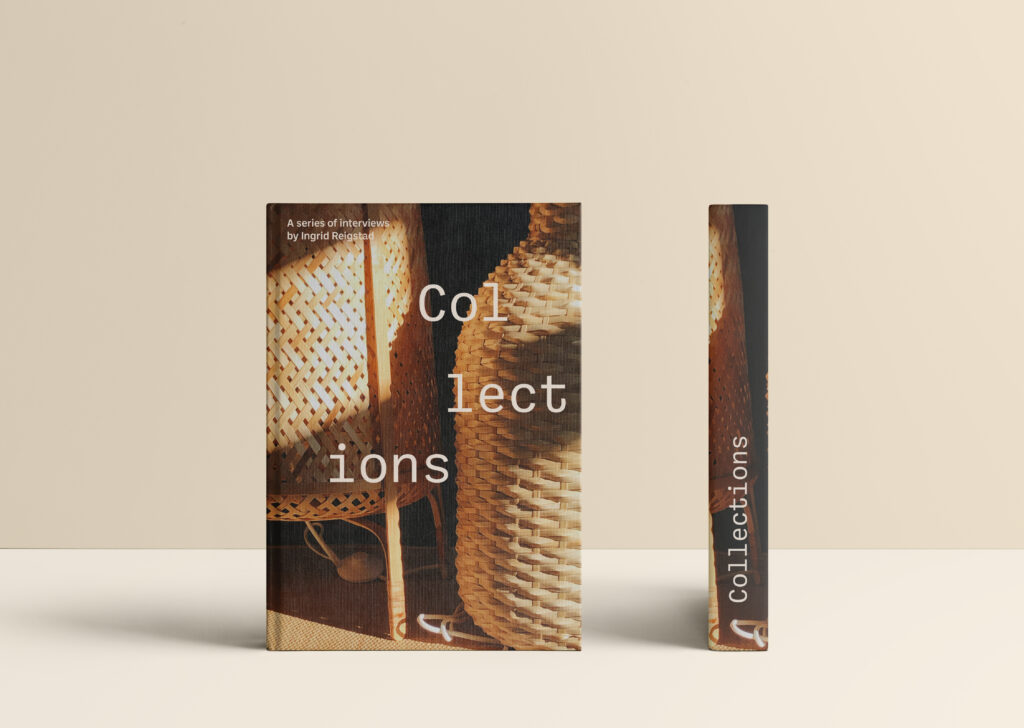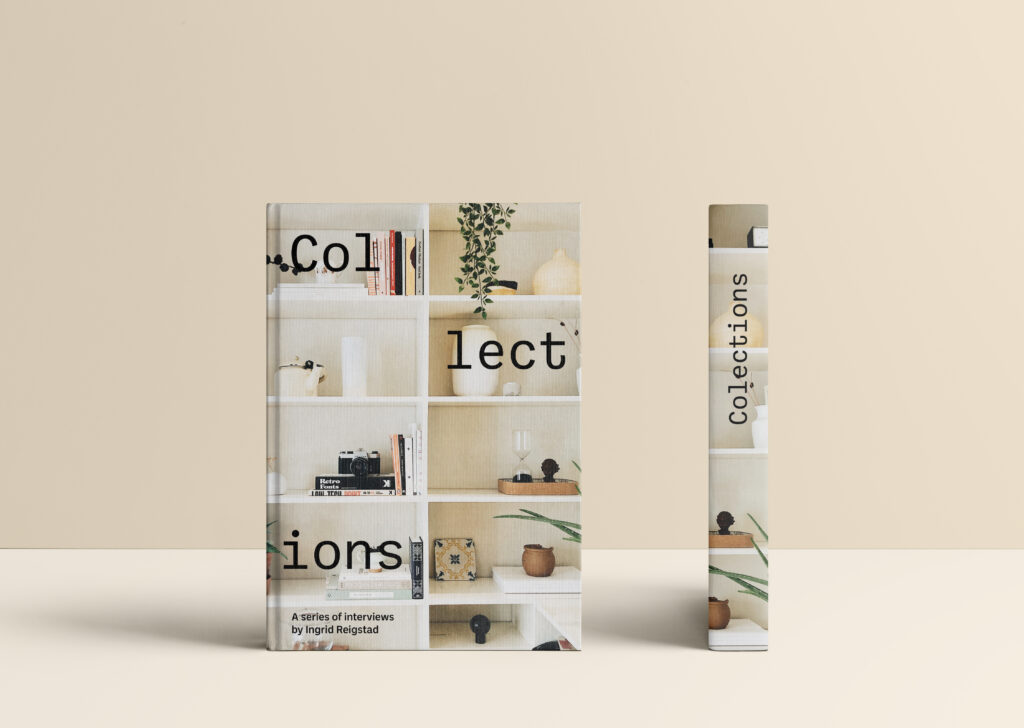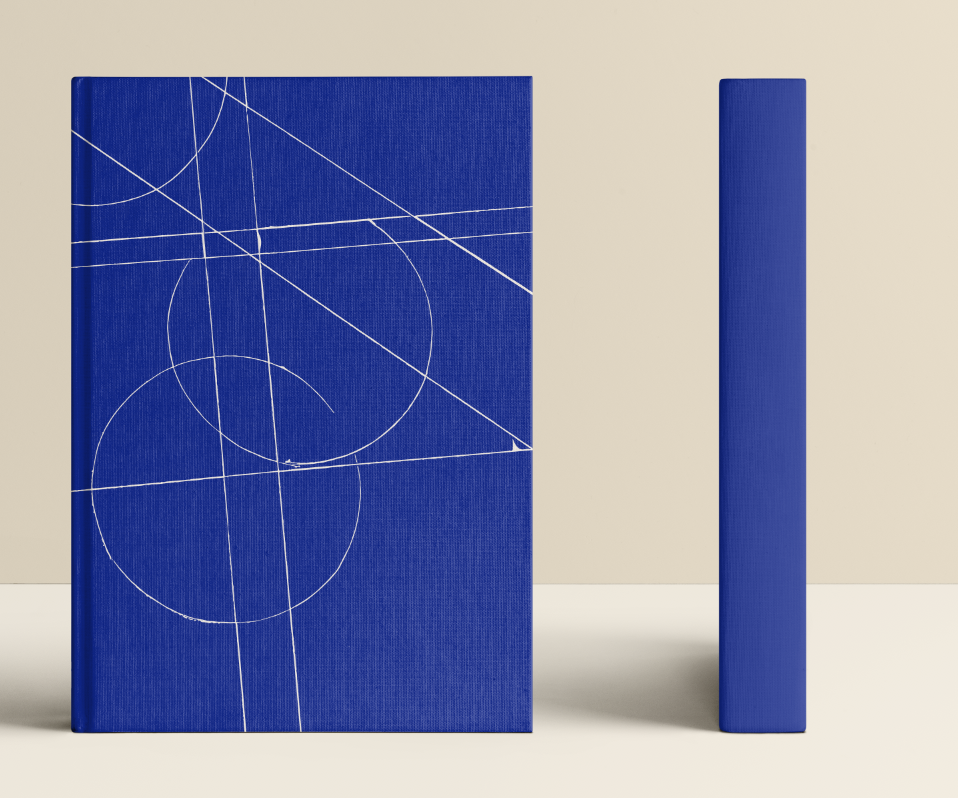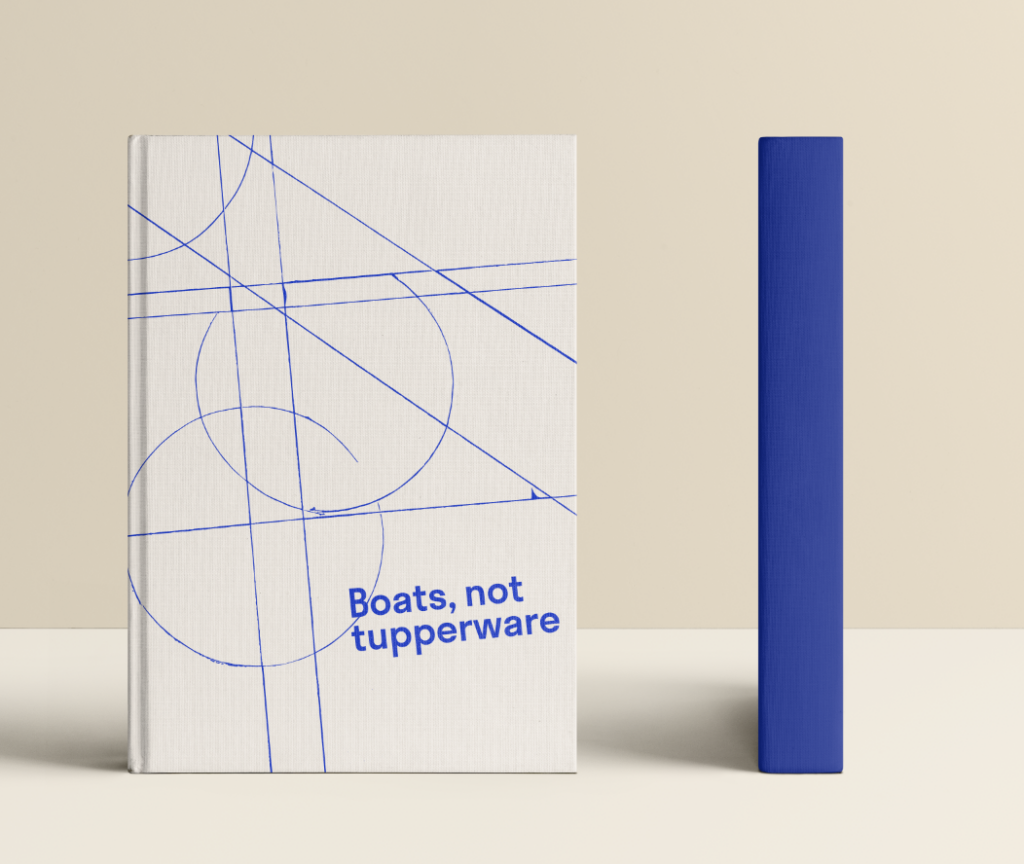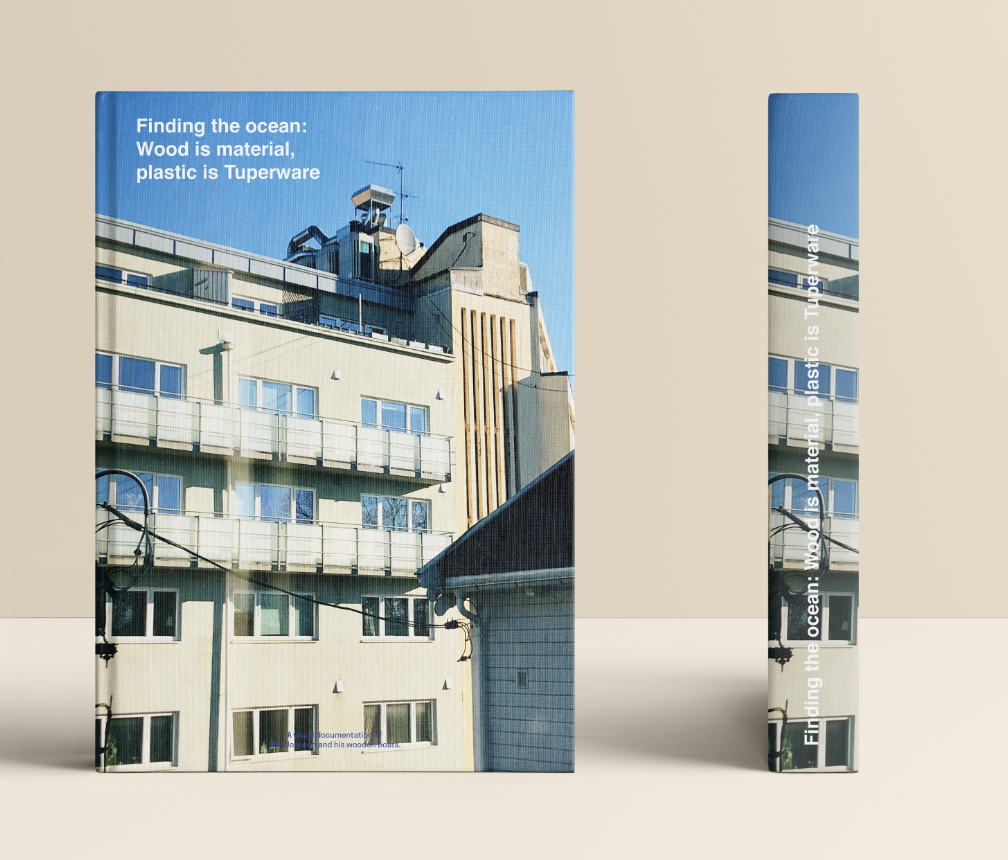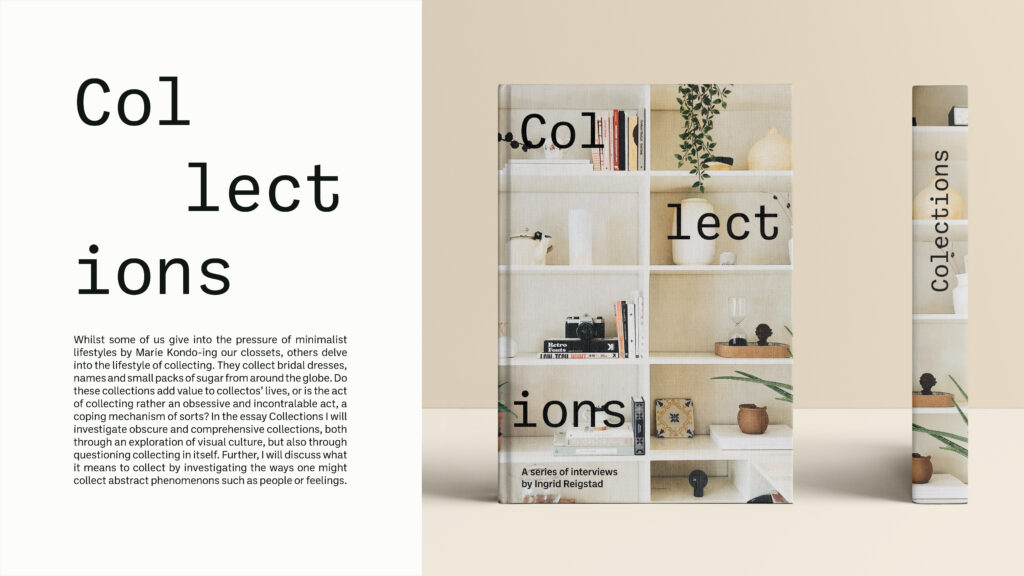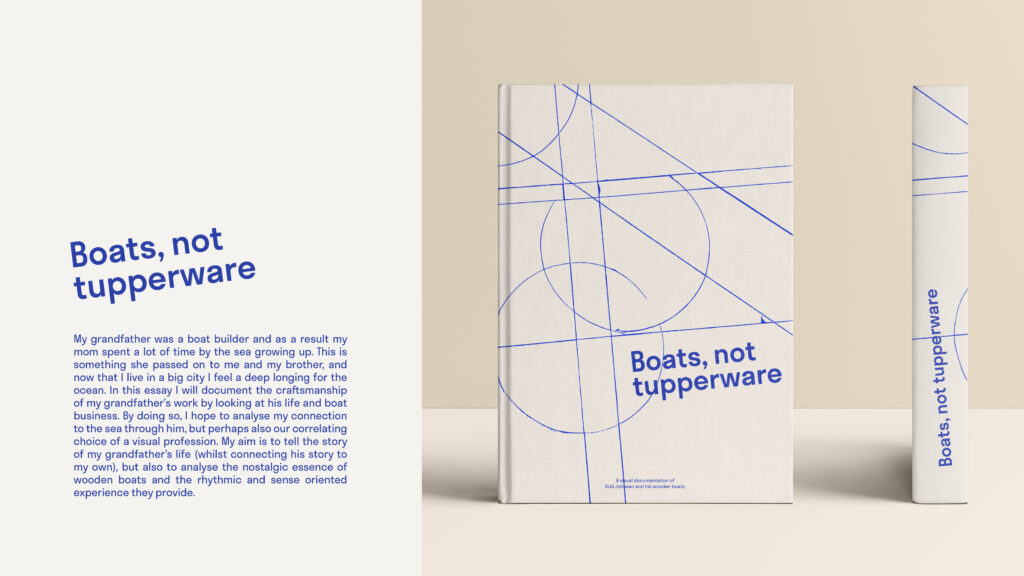Lecture notes
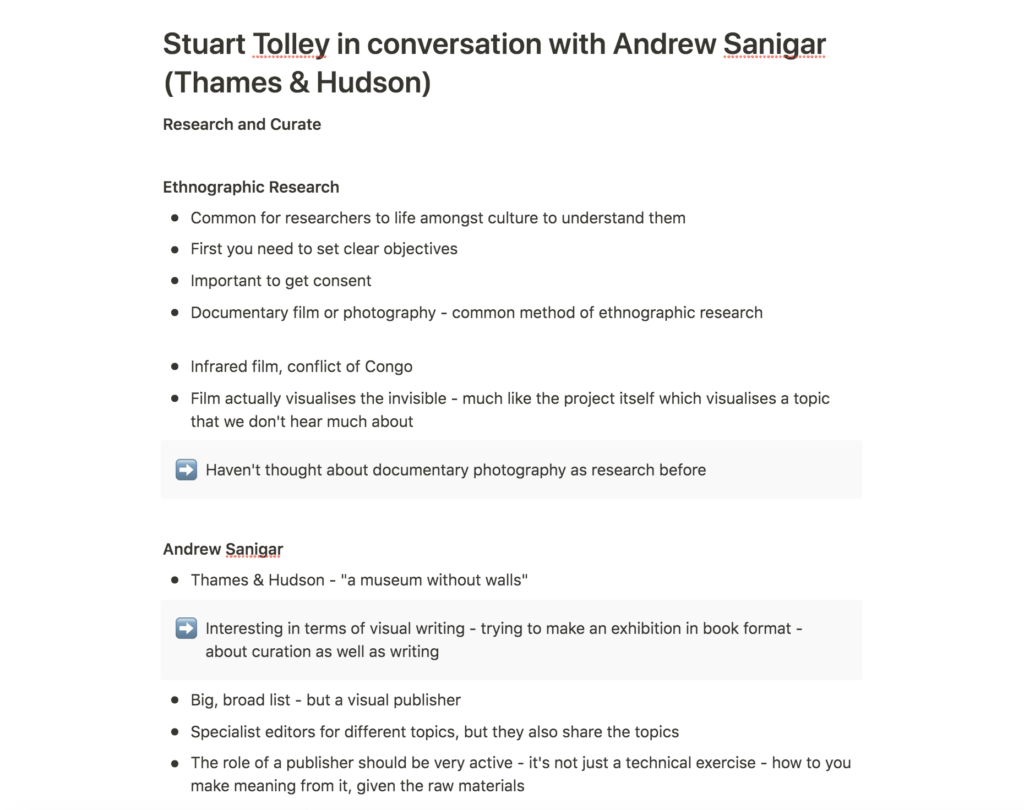
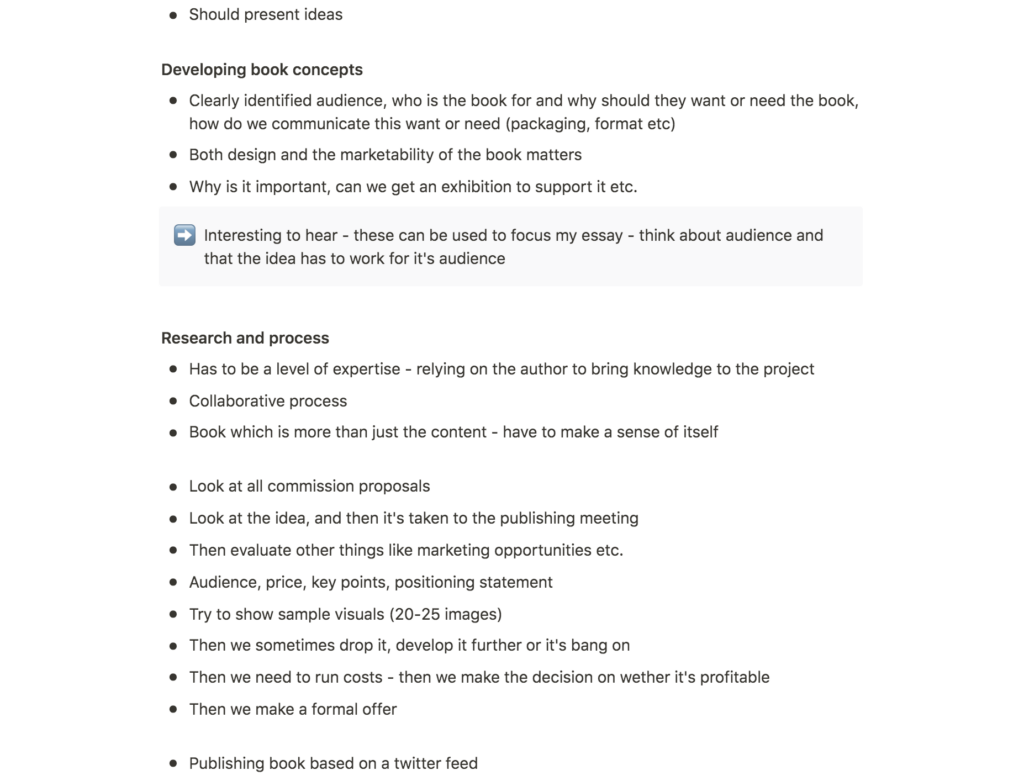
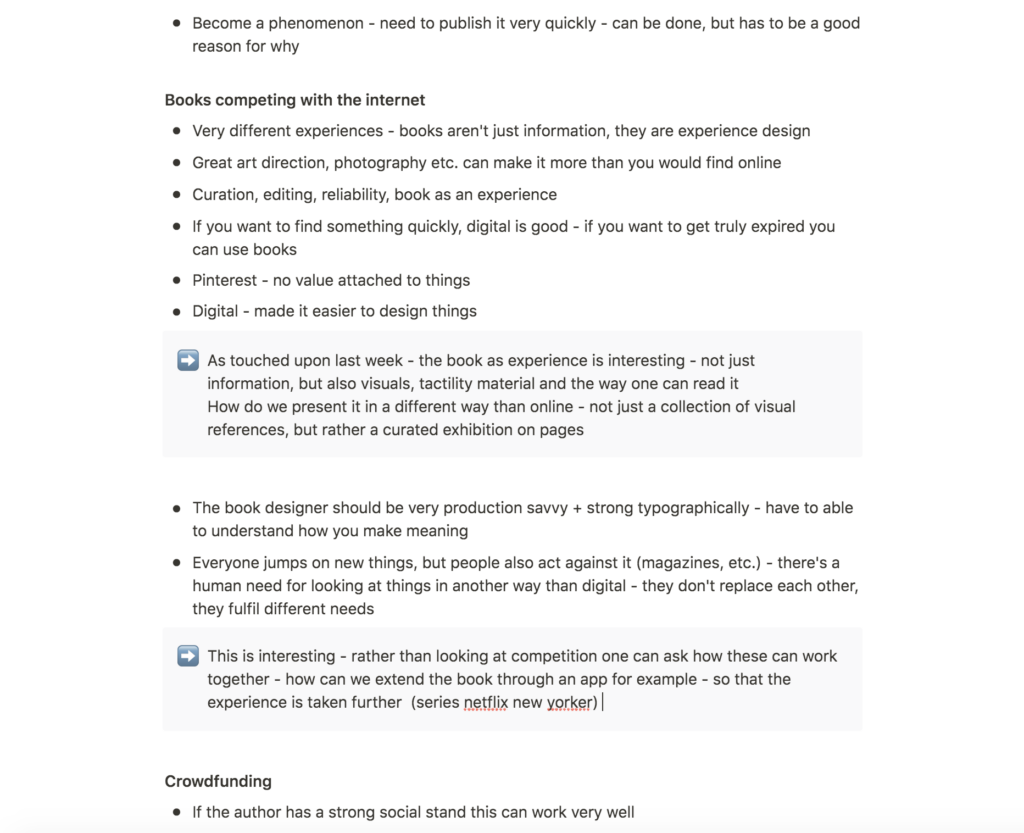

Lecture reflections
The book as experience
I enjoyed hearing Sanigar’s discussions on the book as experience (Stuart Tolley and Andrew Sanigar, 2021). As he reflected on the curatorial essence of a visual book, I wondered how one can truly utilise the tactile essence of the book medium. The slogan, a museum without walls, is very beautiful to me and it’s clear that there is a distinction between the lack of context in digital inspiration feeds, and that the presence in the book is perhaps it’s main advantage. Just as the curator uses a set of methods to convey his message, the book designer should do the same through production methods, format, visuals, text and typography, in order to convey meaning.
How can we tell the story through a variety of formats?
Sanigar seemed to think that digital and physical mediums work in correlation with each other, rather than in competition (Stuart Tolley and Andrew Sanigar, 2021). This made me wonder how one might use this correlation as an advantage. Could the story from a book be carried on and enhanced through digital mediums – perhaps through an app or a website? If so, I imagine that the digital part of the story must provide true value, in order to restrain from being gimmicky. Sanigar’s mentioning of books that also work as exhibitions proved that a story can be translated into other formats (Stuart Tolley and Andrew Sanigar, 2021), and I would be interested in exploring this further.
Resource notes
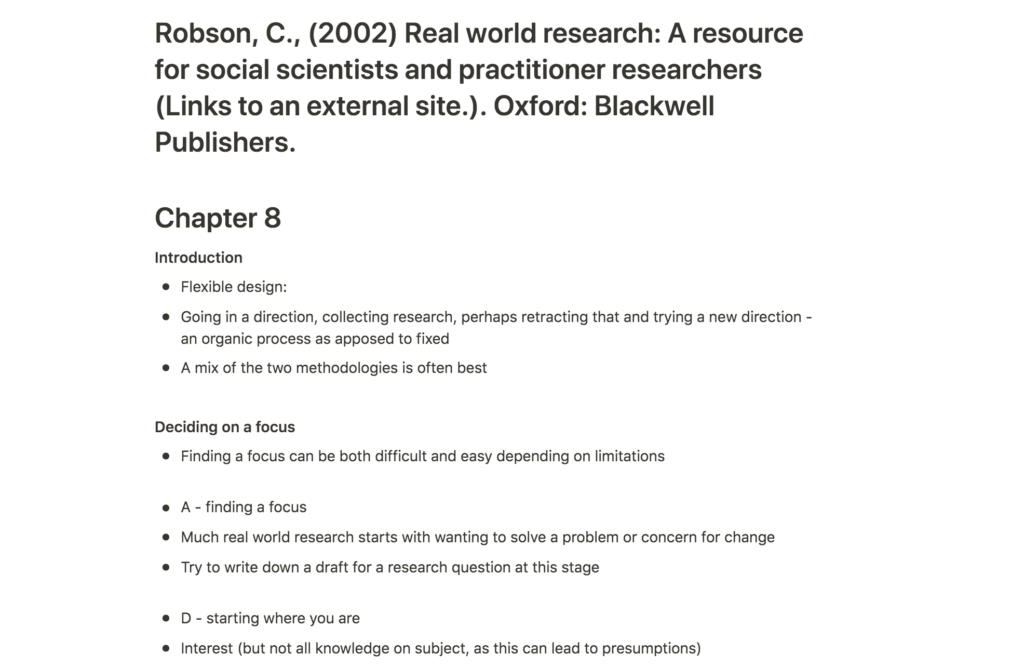
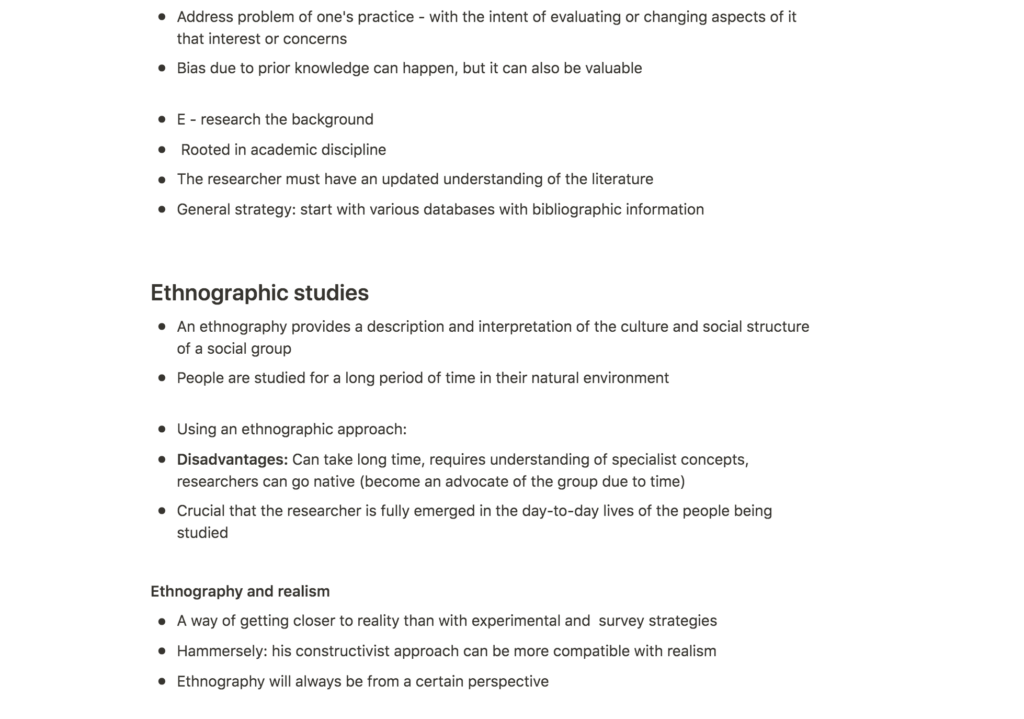
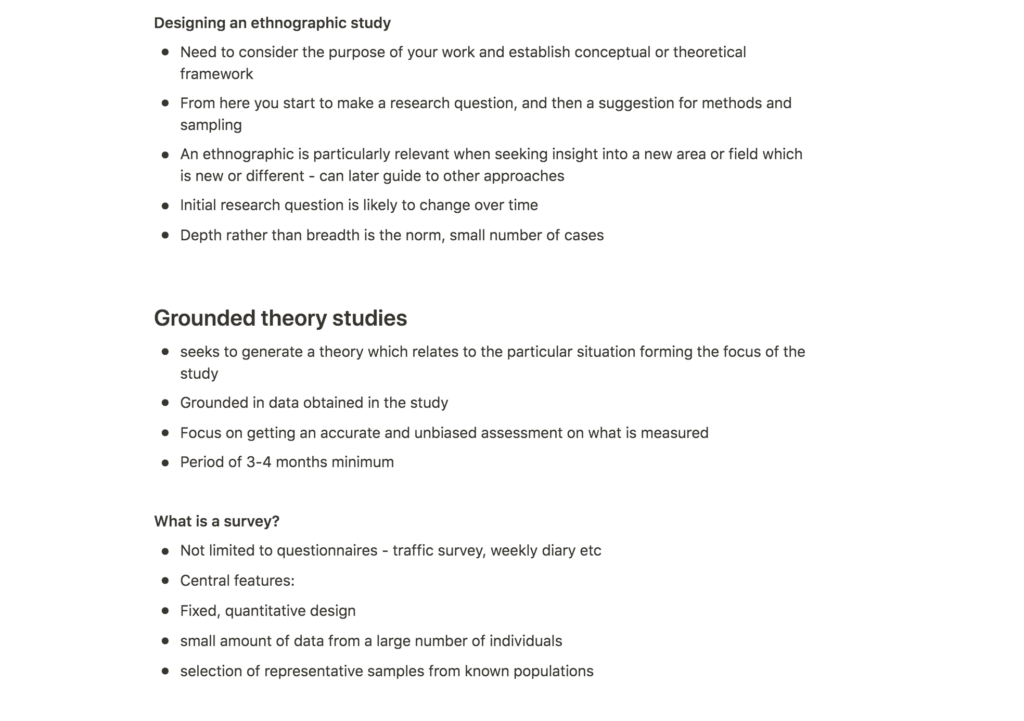

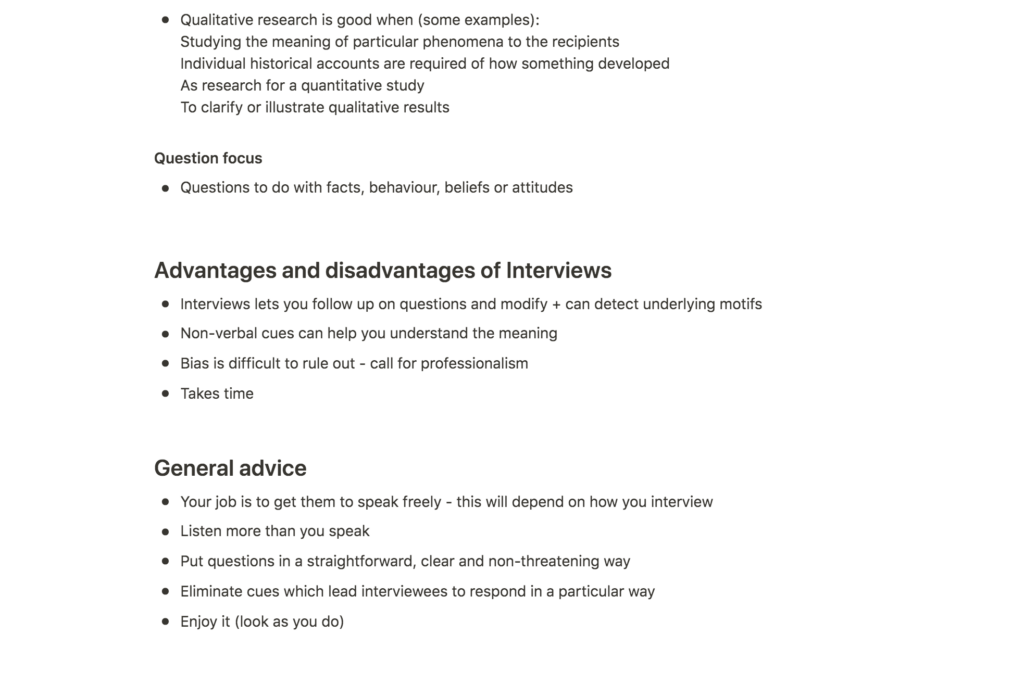
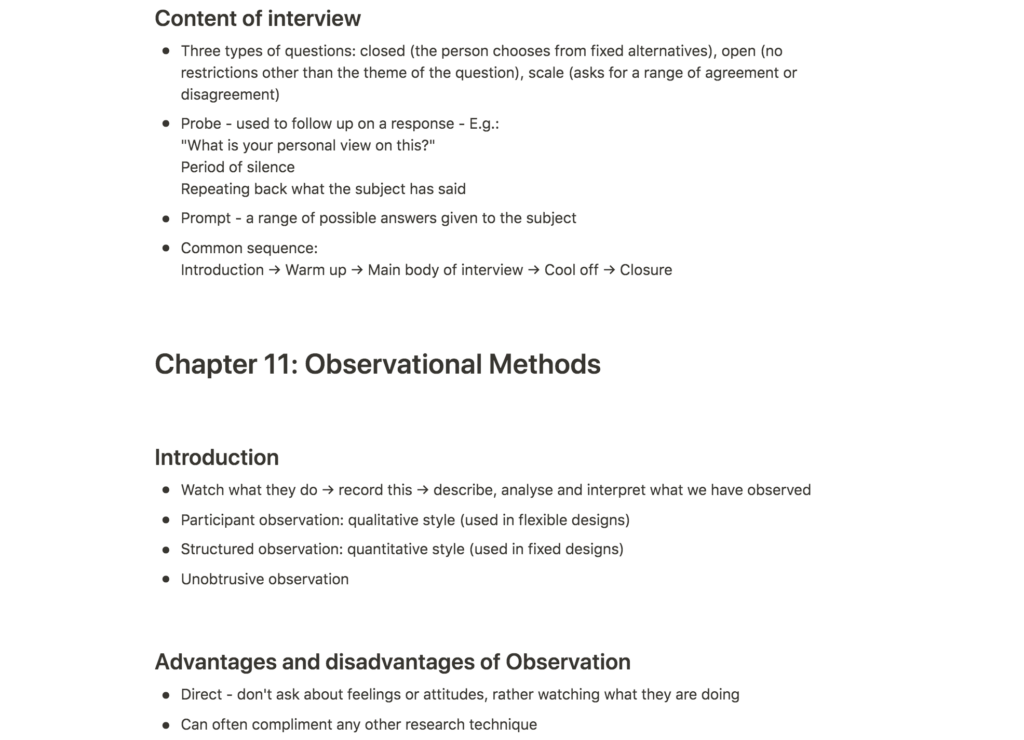
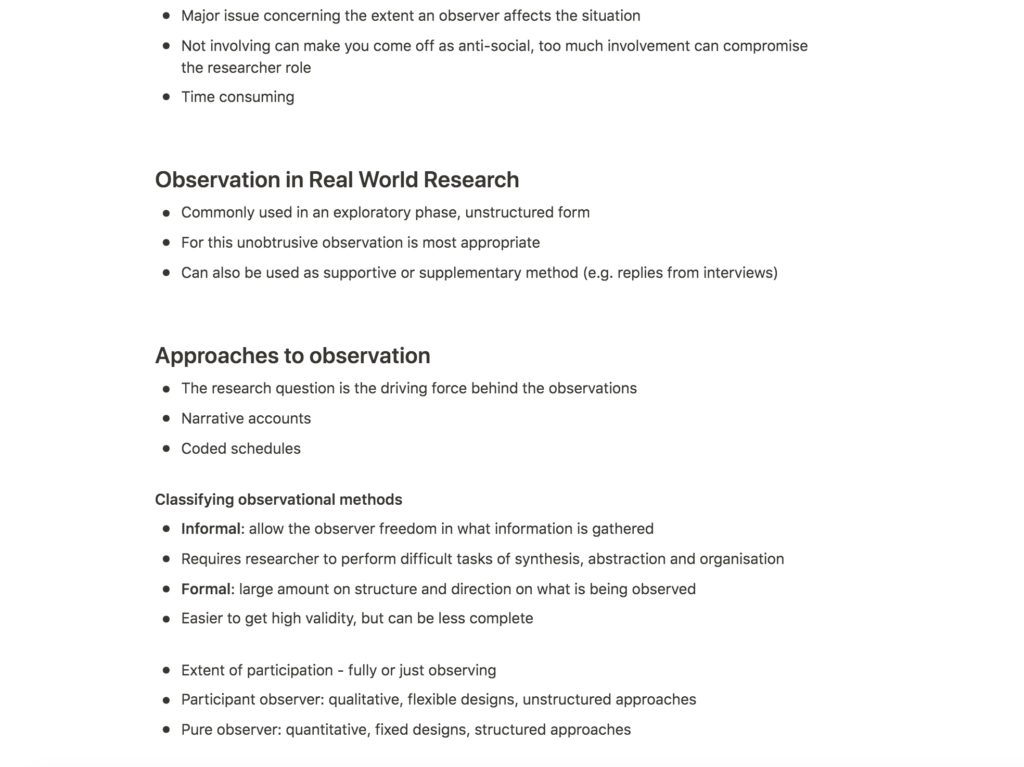
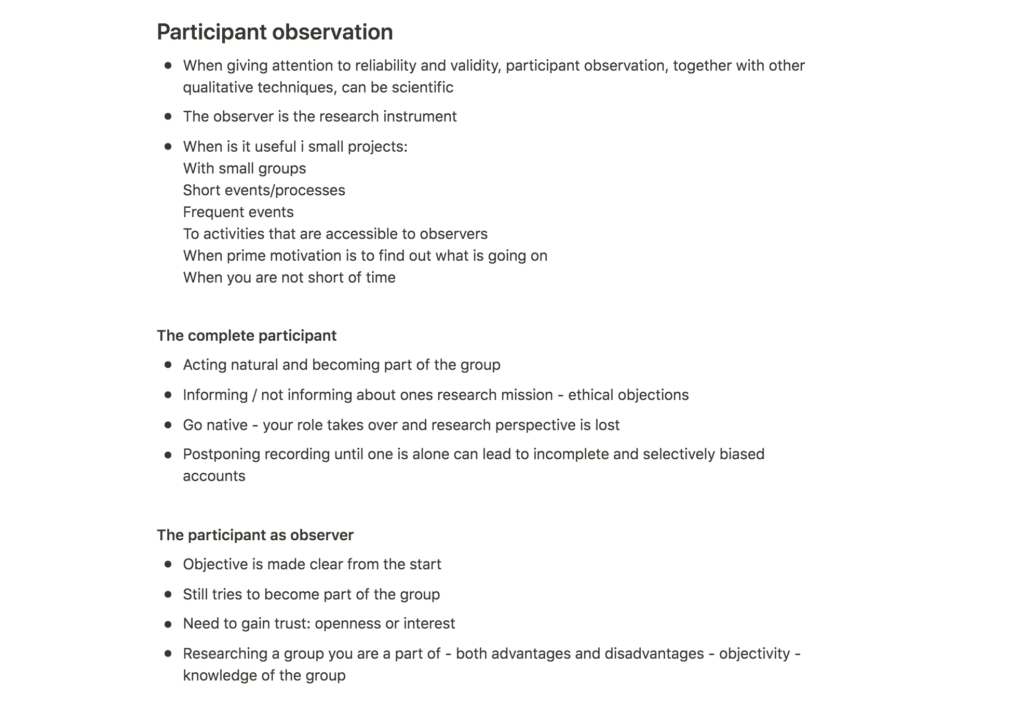
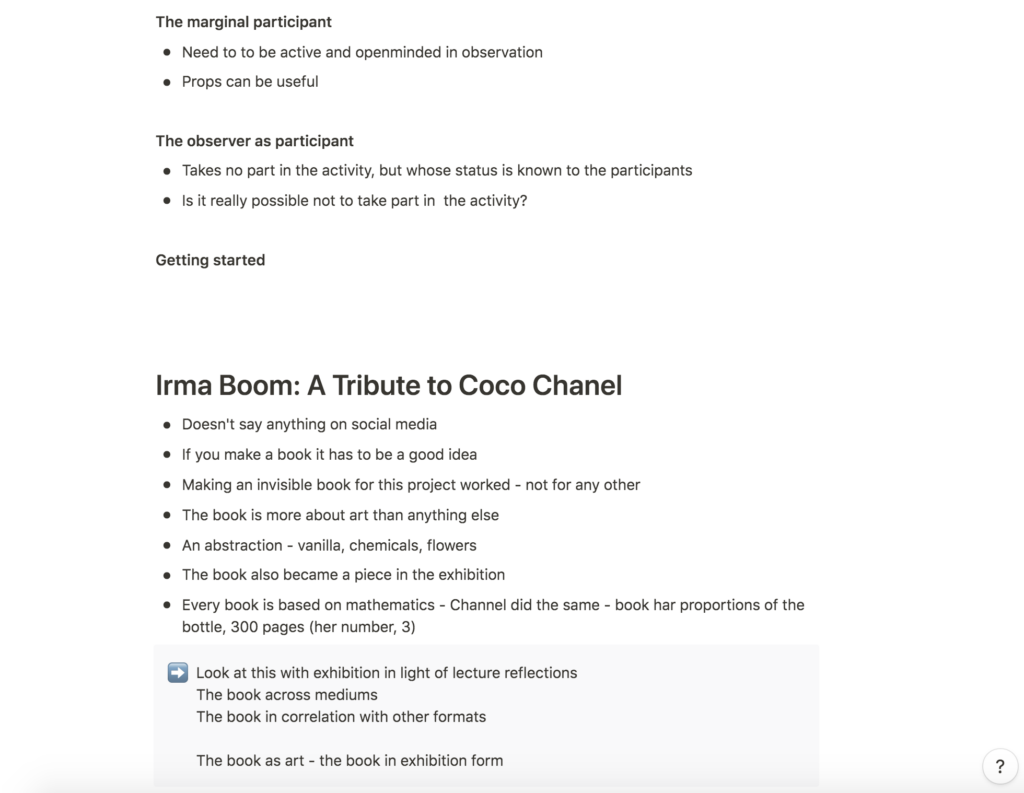
Resource reflections
Robson: Real world research: A resource for social scientists and practitioner researchers
From this week’s reading material, I choose to focus on Robson’s Real world research: A resource for social scientists and practitioner researchers, as this gave me an overview of science research methods. What struck me is that there really didn’t seem to be one approach to research which would ensure validity. Rather, it seems as if a researcher must make sure to analyse possible errors as he or she designs the research design and draws conclusions based on results (Colin Robson, 2002).
Irma Boom: A Tribute to Coco Chanel
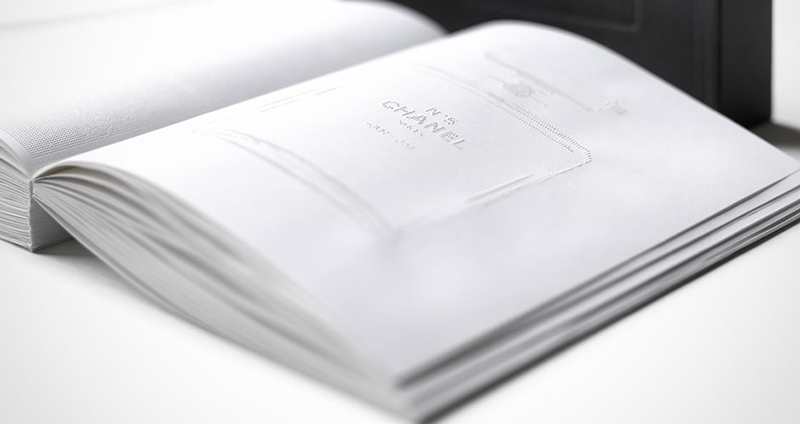
Monopolising information by removing digital visibility
Drawing on my reflections on print and digital working together, I was intrigued by Boom’s comment on how her book doesn’t work digitally as the pages would be white (Irma Boom, 2016). Thus, the experience of the book becomes monopolised in a way, forcing people to read the actual book for the provided information.
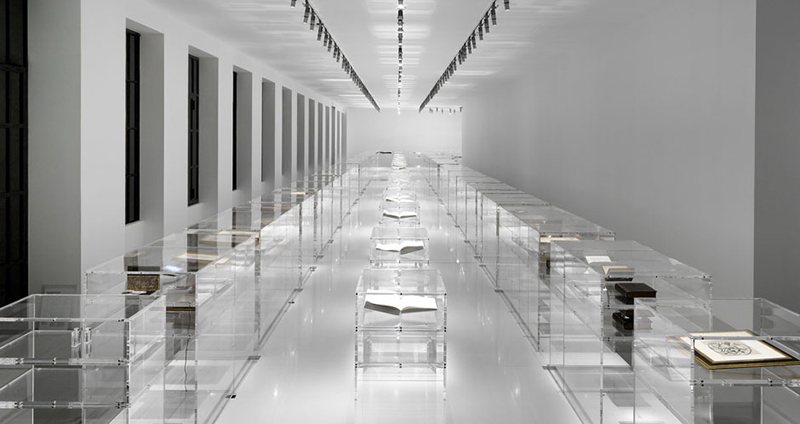
The book as exhibition
Although the book does not work digitally, it was beautifully displayed in the the exhibition for which it was made. I wonder what happens to a book’s function as it is removed from the users’ hands and placed in the place of an art work. In the exhibition, people could not flip pages or feel the texture of the embossed pages. Does this mean that information was somehow lost?
As the book was displayed in an exhibition format, the embossing of pages was highlighted using light sources, enforcing the message of the production method. By displaying the book, the curator also forces the users to study one spread carefully, and therefor the way it is made, rather than the story and content of the pages. So as we move the book from hands to display, information might not be lost, but the message might change.
I find this matter of context very interesting and I think it could be interesting to investigate it further in my essay. Perhaps an approach could be “How do people perceive the communication of a book as we shift it’s context?”. A school book for example, would communicate very different things depending on wether it’s seen in the class room or in a gallery.
Further research
The war paint box
The war paint box is a great example of how a book can go beyond the format of a book and become an experience which can not exist online. As a box of objects, rather than a book on it’s own, looking through this piece becomes an act of exploration as the user has to go through all elements. As the artist has passed away, the box becomes a sentimental element, reminding me of how one has to go through a relative’s belongings after their passing. Thus, the experience also feels intimate, and perhaps slightly intrusive.
Mini Zine
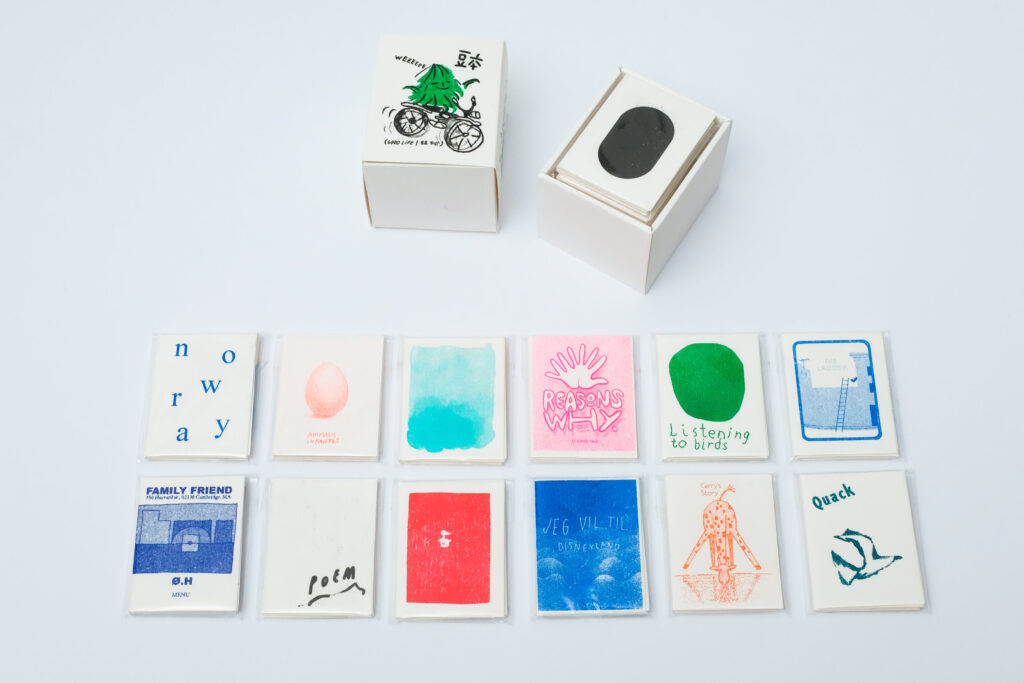
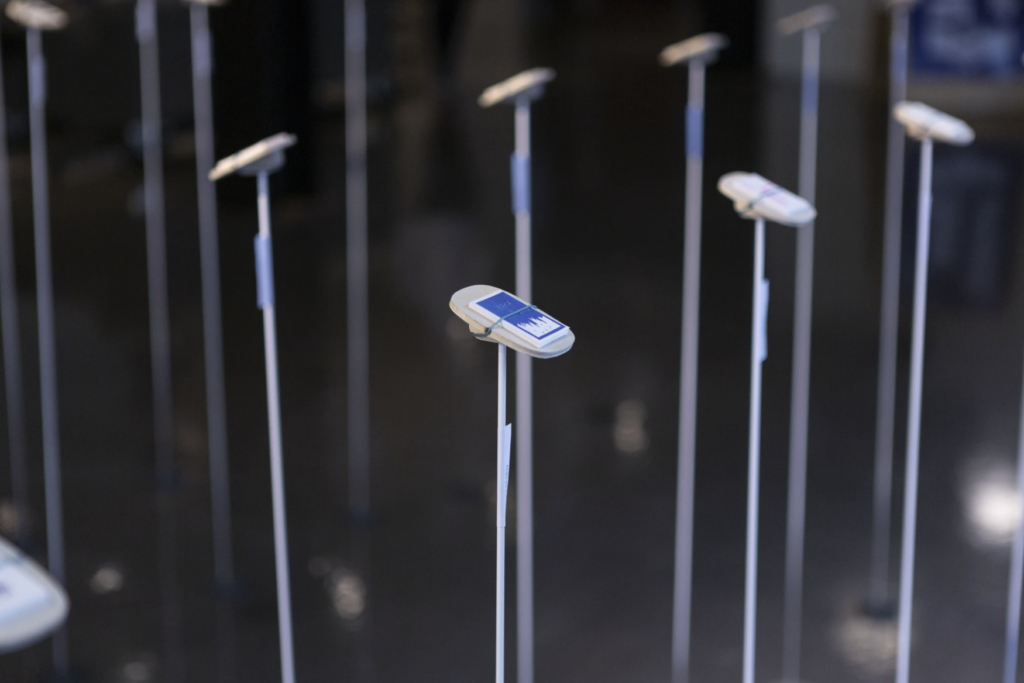
Norwegian Mini Zines is an exhibition that was set up at the Norwegian gallery GRAFILL R21 in 2019. The mini format is lovely and the exhibition is a great example of publications working in an exhibition format. I really like the riso printing technique used, as it unifies the collection of zines which have been created by a variety of illustrators.
Workshop challenge
In order to choose two topics I started brainstorming. My initial ideas were Norwegian inventions, Collections and the nostalgic connection to a place. From here I used a mind map to develop further ideas. I was initially quite confused as to deciding on topics, but Paul guided me in the right direction, which led to the ideas below.
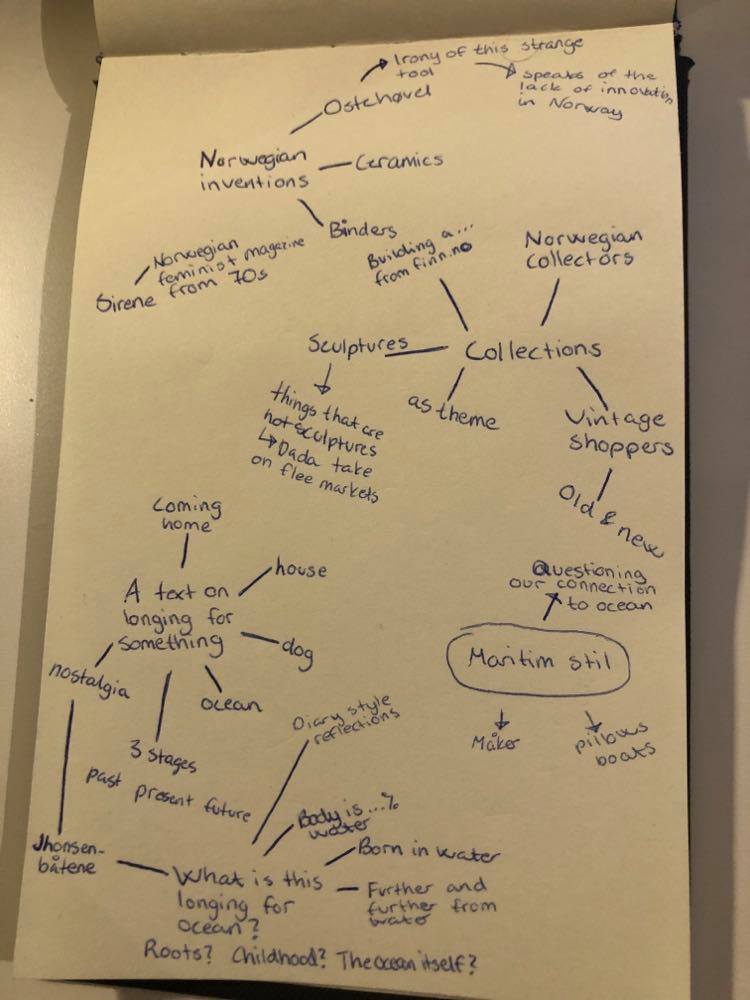
Although I did not pursue this further, I also had the idea of looking at a feminist Norwegian magazine from the 70s and 80s, Sirene. We don’t have a lot of recordings on historic women in graphic design in Norway, and to write about the magazine’s designer, Sissel Biong, could therefor have been an interesting input to Norwegian graphic design history.
Idea 1: Collections
My first idea for the essay is to focus on the act of collecting. In Oslo, it’s become quite popular to buy and collect vintage interior and there are a lot of nice vintage furniture shops (they are however closed at the moment due to Covid). I think it could be interesting to talk to people with strange or impressive collections. The act of collecting is also quite fascinating to me, especially when the objects are attached to meaning or memories. If I am to meet collectors, I would like to investigate this act and urge to collect, rather than solely focusing on their objects in themselves. I imagine there must be some wonderful niche collections out there, that might result in an interesting book project. There is also an environmental act in collecting vintage objects, as it is a circular action as apposed to buying something new.
Idea 2: Nostalgic connections to the sea
My grandfather was a boat builder and my mom therefor spent a lot of time by the sea. This was translated to my childhood as well, and living in a big city at the moment, I do miss living close to beaches and the ocean in the way one does in my hometown (Oslo is close to the ocean, but the sea is not very accessible). I think it could be personal and rewarding to create a project about my grandfather’s boats, perhaps also by looking at my personal attachment to the sea by looking to my roots. By including my personal longing for the sea, I would also answer to the city aspect of the assignment. Unfortunately my grandfather passed away several years ago, but I think I might be able to research into his life by talking to other family members.
Concept 1: The act of collecting
When I had decided on my concepts, I created a short bullet list for each one, planning potential research methods. I have divided my process into 2 in order to communicate each concept in a structured way, so please scroll further down for my second concept.
For concept 1 I considered the following research ideas:
- Depth interviews with collectors in Oslo
- Visit local shops if possible with current Covid restrictions
- Look up news stories on collectors
News stories on collectors
Although I haven’t contacted them directly, I thought it could be a good idea to look into Norwegian people who collect, as I might be able to get in touch with them later in the project if I go ahead with this concept.
Jan Roger Elstad’s wedding dresses:
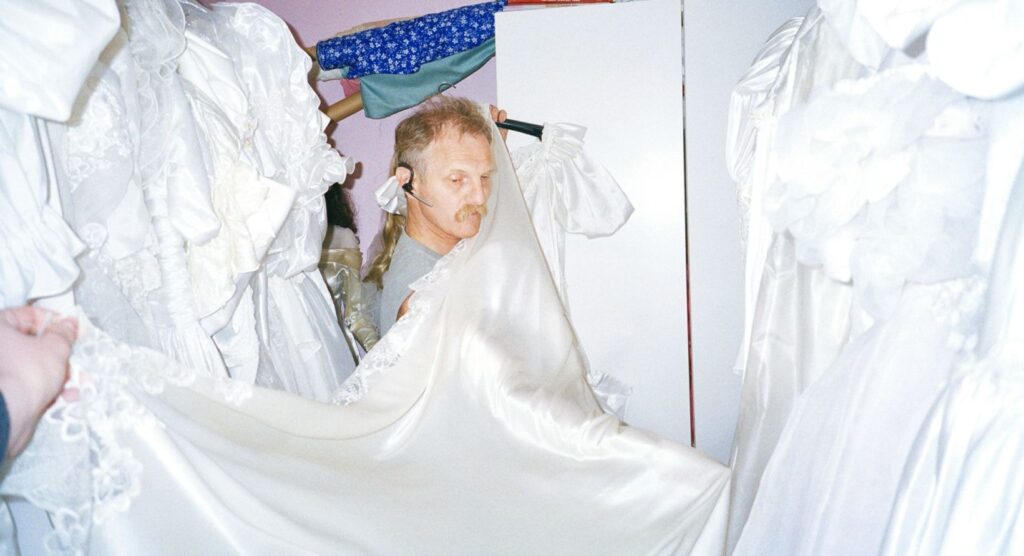
The image above describes perfectly why I found Jan Roger Elstad’s collection so fascinating. The feminine white dresses play a big contrast to Elstad, who drives a truck for a living (Bjørg Aftret and Hilde Marie Tvedten, 2017), and his typically masculine features. I would be very interested to interview him and to get to know more about his life.
Ole-Jacob Jorsett’s sugar packs:
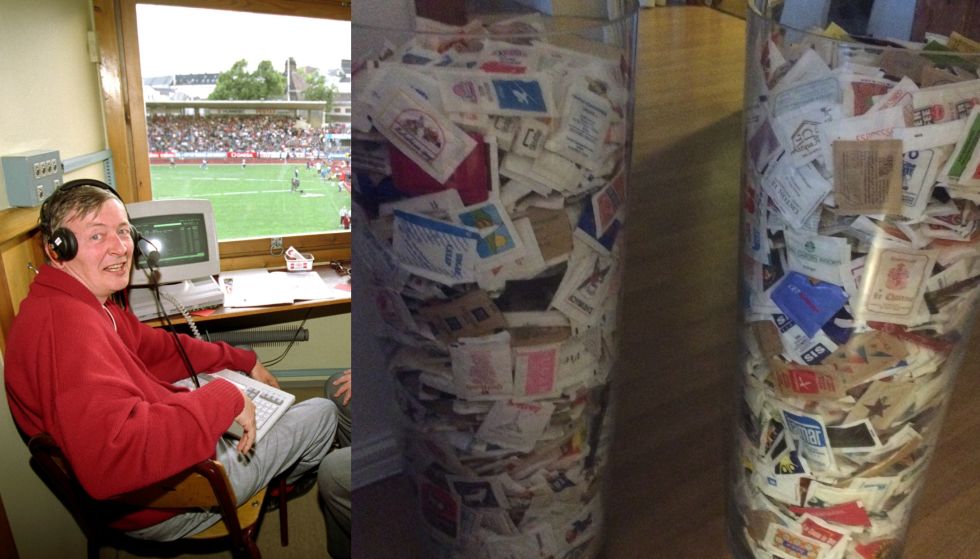
Ole-Jacob Jorsett is a retired sports commentator who collects sugar packs from around the world (Karin Madshus, 2021). He also collects several other things, but I am particularly interested in the graphic design aspect of the sugar packs. I imagine that they would look beautiful if they were taken out of those plastic pipes in order to be scanned/photographed and curated in a book. The fact that he has collected the sugar packs from various areas of the world is also interesting in a cultural aspect.
What is a collection?
Art collections and the act of preserving them
Moving past the act of collecting objects as a hobby, I started reflecting on the word collection in it self. There are of course collections in museums, for which there are people responsible. Thus, it could be interesting to talk to or read interviews with those who take care of art collections. There are also some interesting articles on the Munch museum (which holds one of the world’s largest art collections from one artist (Munch museet, 2020)) about the conservation of Munch’s paintings and how far we should go with it.

A collection of people
In Norwegian “a collection” (“en samling”) can also mean “a meeting” or “a collection of people”. “To collect people” could be translated to “to gather people”. This made me think of people who work for the common good, by collecting and unifying people in some way. Diplomats are perhaps collectors of people as they work for peace.
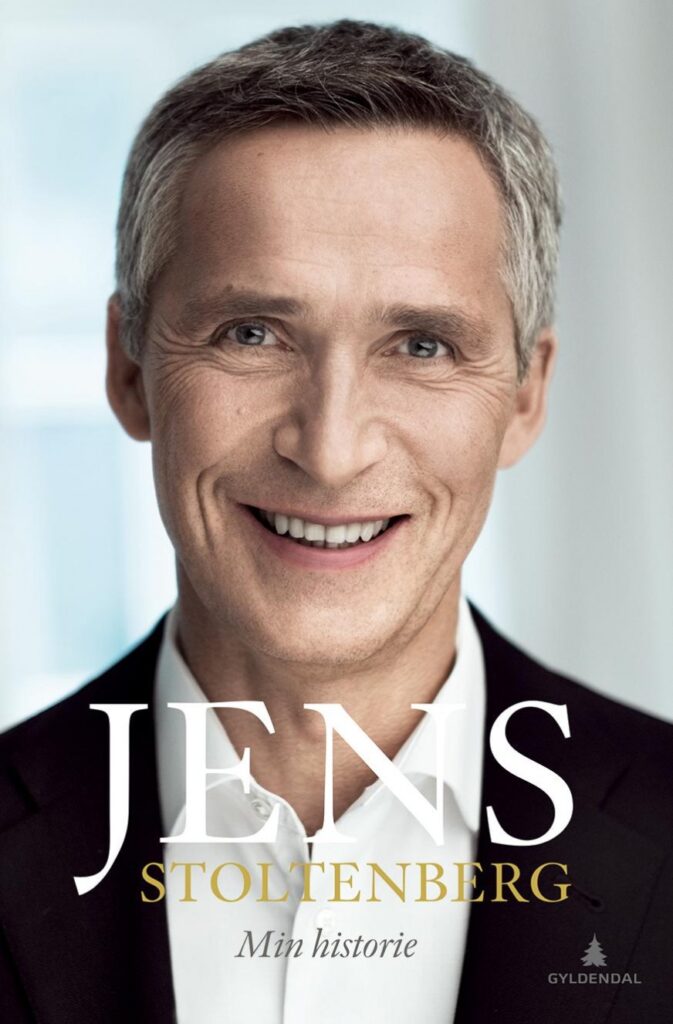
Jens Stoltenberg, former prime minister of Norway, currently work as the general secretary of NATO. If I am to pursue this project (and the idea of people collecting people), it might be interesting to use his book as research material. However, I also think it could be fascinating to talk to a much less known politician if I am to discuss individuals alike, as they might be more in line with everyday collectors.
Further interpretations of the word “collection” might be religion, as religion also gathers people in a way. A more emotional approach could be to look at those who collect grief or memories from an unfortunate event. An interesting approach to the book could be to interview or write about 5 collectors, and in doing so reflecting on the ups and downs on what it means to collect. The text could perhaps start with visual culture and develop into a more abstract place, perhaps symbolising how visual culture can be tied together with abstract phenomenons.
“I furnish Grünerløkka”
I wasn’t able to visit shops due to Covid, but I did find the video above with an interview with who seems to be the owner of Antikkvarehuset, one of Grünerløkka’s largest vintage furniture shops. I didn’t have time to ask for an interview with him, but if I go ahead with this concept I might try to set one up.
In the video, the owner discusses how the furniture in the shops were bought with the intension of passing them down through generations (Gule Sider, 2016). Further he says how much he likes seeing young people and their parents in his shop, investing in retro furniture for their first home (Gule Sider, 2016). It seems as if this man has a close connection to objects, in the same way as other collectors, but perhaps with a different intention: to take care of and pass them down. This caring aspect is something I would have liked to discuss if I was to interview him.
Semi structured interview
My plan was initially to interview 3-4 people, in order to understand more about the act of collecting. However, a few of the interviews fell through and so I was only able to do one collector interview this week. Luckily I got some great insights on the pleasures of collecting. The interview was in Norwegian, but I have translated the most interesting parts in my notes:
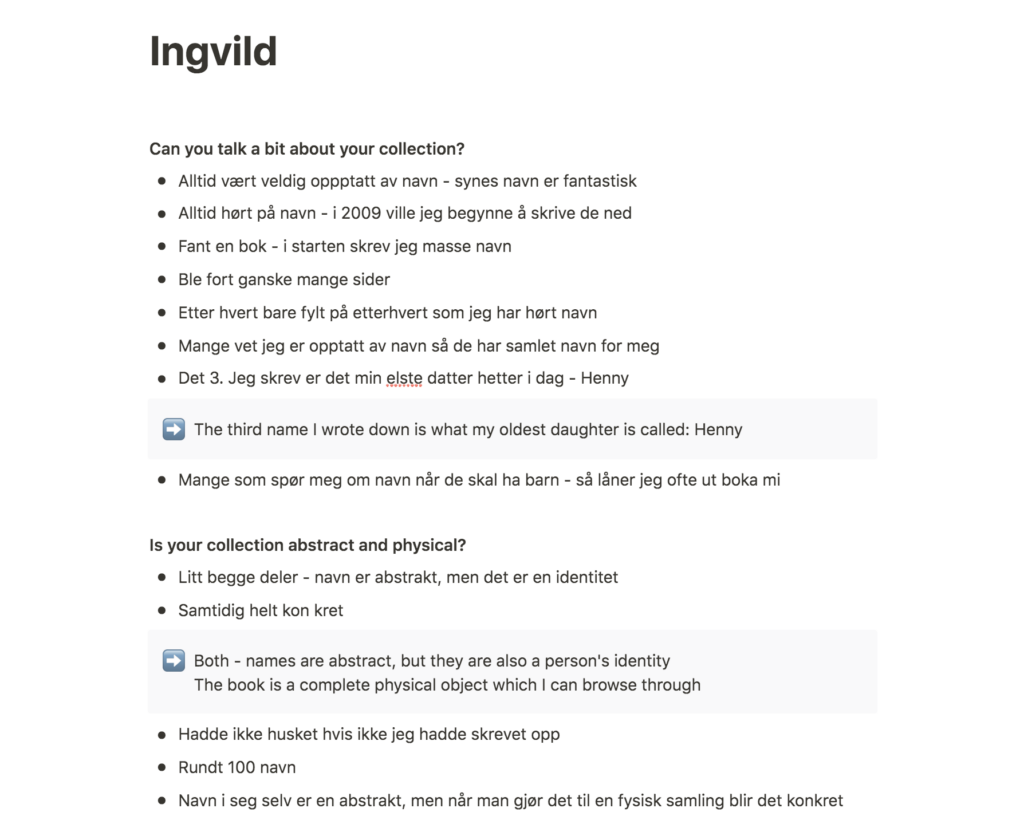
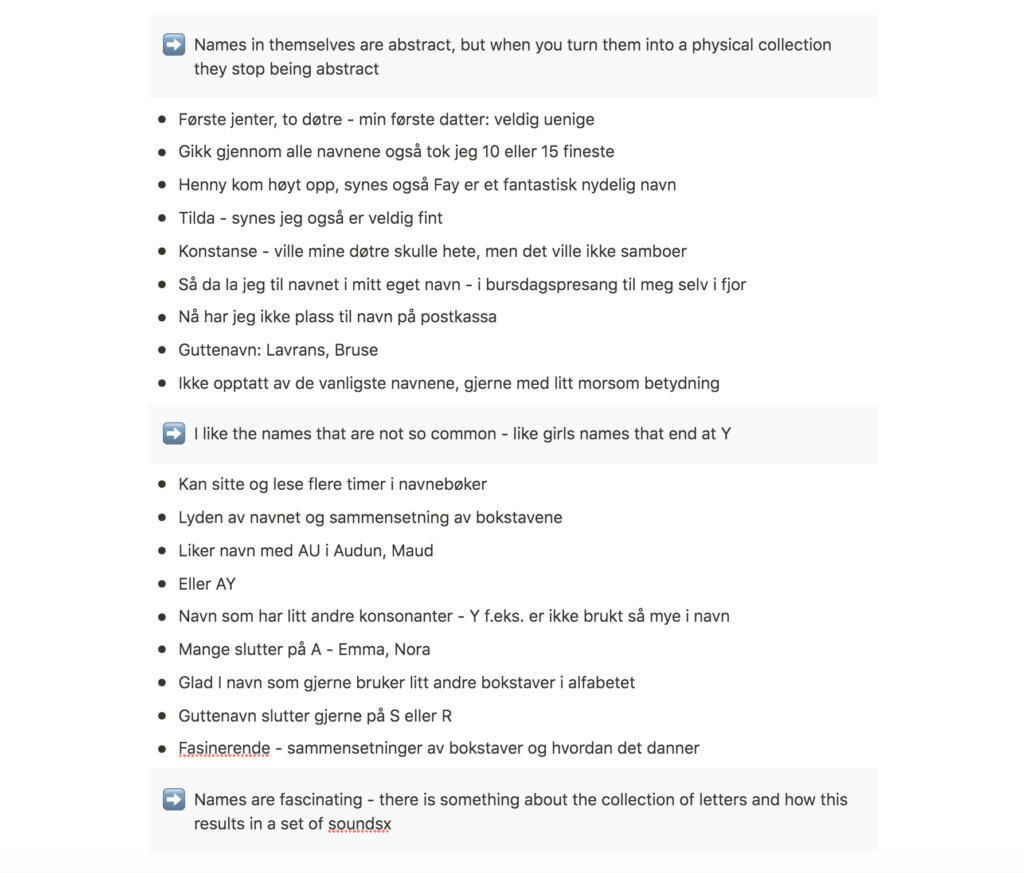
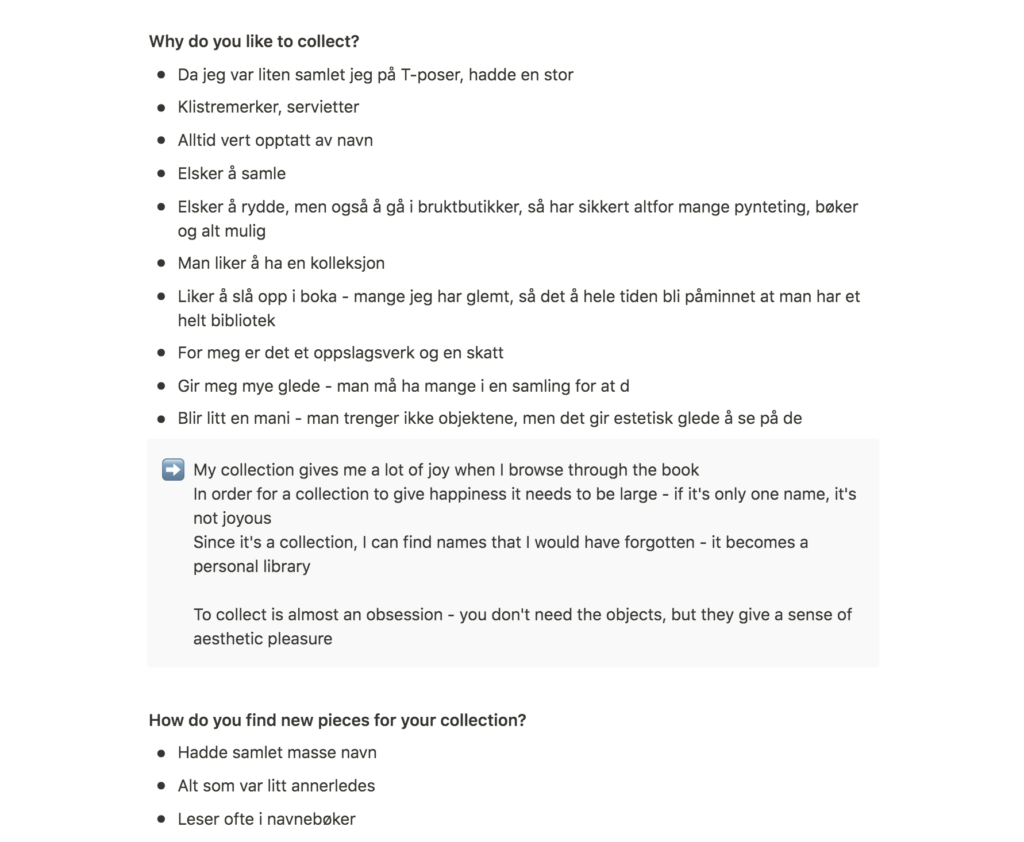
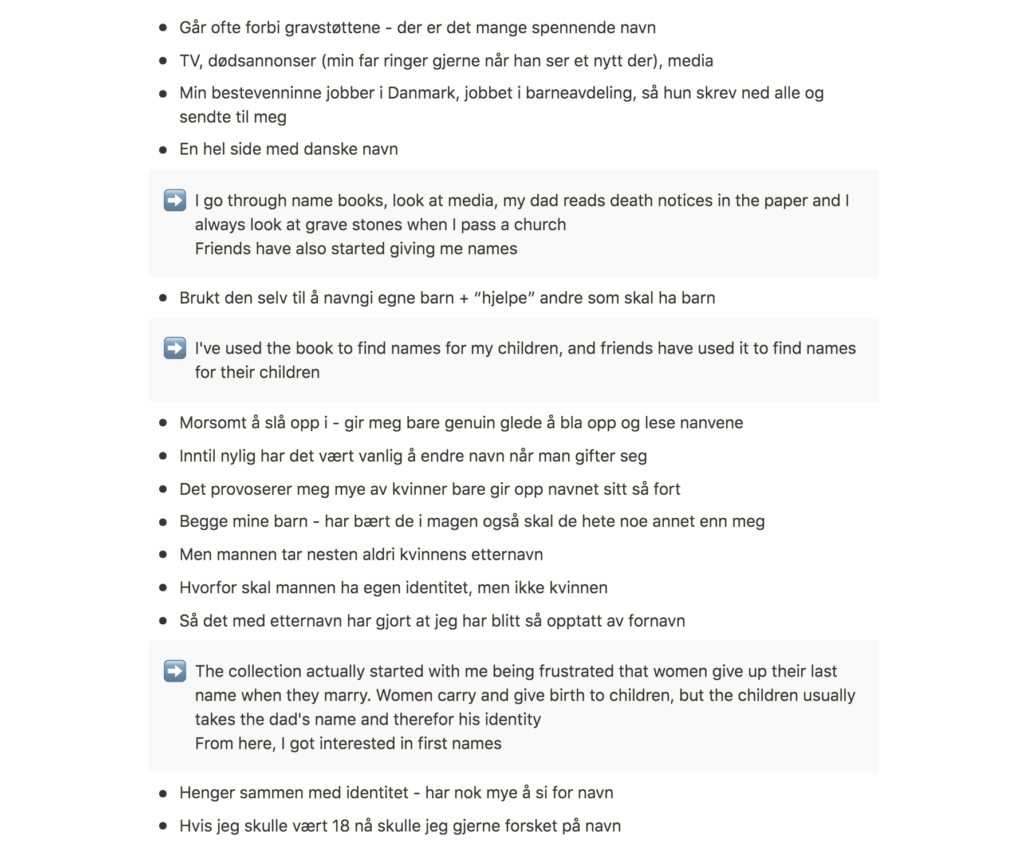
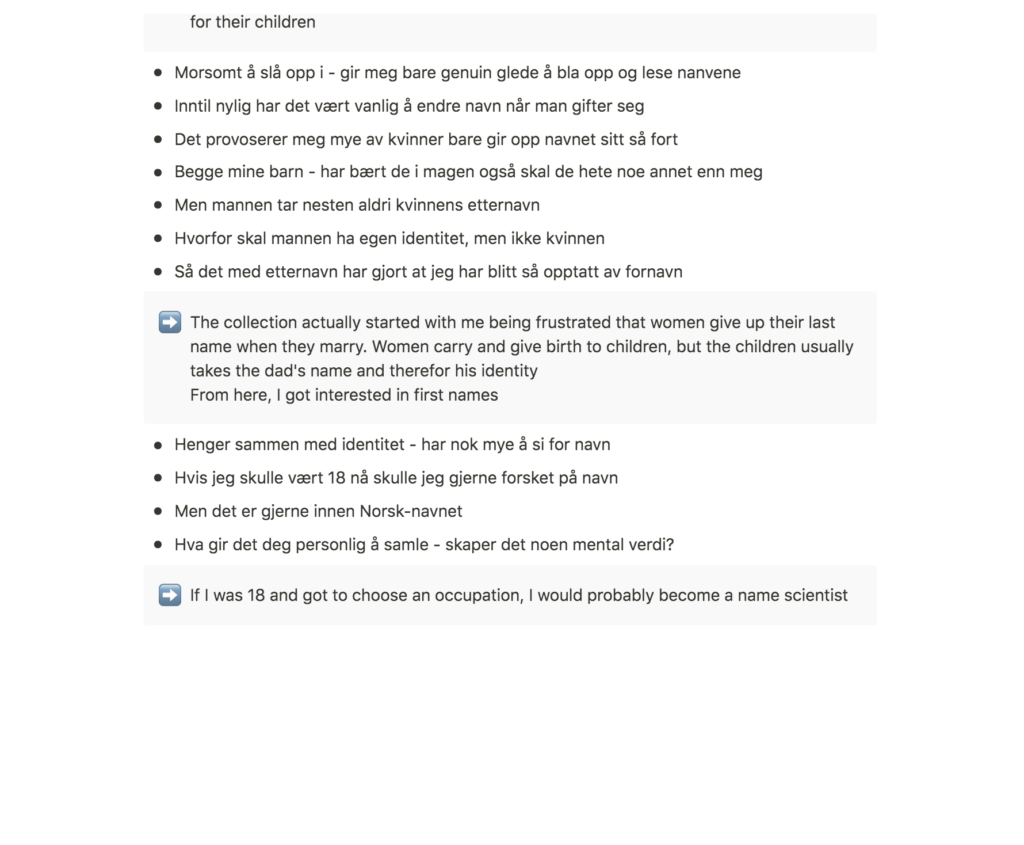
What I really liked about Ingvild‘s collection, was that it was both abstract and physical. Since 2009 Ingvild has collected names in a book, and the book has helped both her and her friends name their children. As we were talking, it became clear that she was fascinated with names due to the correlation between letters and sounds, but also the connection between names and identity. It was fascinating to listen to Ingvild’s thoughts on her own collection and I think a series of similar interviews, paired with photographs, would make for an interesting visual essay.
Image
This week I have chosen to focus on gathering research for my essay. I therefor wasn’t able to spend as much time on a thorough process for my visual work as I would have liked. As I wasn’t able to meet and photograph collectors (both due to the fact that I struggled with getting in touch with people, and due to Covid restrictions), I didn’t have much visual material to base my image on. As I was working through my research, I had started to imagine this concept as a photo journalism project, which would document stranger’s collections through photography of people with their collections.
Considering the photo journalism aspect, I decided to photograph some of my own interior collections at home, in order to start building a visual style for the concept. As the essay would be photo driven, I decided to create a book cover where photography was the main element. I also split up the word title in order to represent the different objects in a collection.
I do quite like this photo driven style and since I come from a photography background it was fun and rewarding to work with photography in my design. I do however wish that the photos could have been of people I had interviewed. Considering I haven’t been able to source the right material for this concept, I will have to put in a lot of work over the next week if I am to choose this direction.
The mockup used in this work was collected from a website with a creative commons license, and was not created by me.
100 word synopsis
Collections
Whilst some of us give into the pressure of minimalist lifestyles by Marie Kondo-ing our clossets, others delve into the lifestyle of collecting. They collect bridal dresses, names and small packs of sugar from around the globe. Do these collections add value to collectos’ lives, or is the act of collecting rather an obsessive and incontralable act, a coping mechanism of sorts? In the essay Collections I will investigate obscure and comprehensive collections, both through an exploration of visual culture, but also through questioning collecting in itself. Further, I will discuss what it means to collect by investigating the ways one might collect abstract phenomenons such as people or feelings.
Concept 2: My grandfather’s boats
For concept 2 I considered the following research ideas:
- Talk to family members about my grandfather’s life and boats
- Collect images from family and online
- Research why humans have a strong connection to the ocean
- Analyse my connection to him and the idea of his boats being used
- Look at boats and the ocean as a symbols
The physical effect of water
In the article Why we are so attracted to the ocean, Shweta Venkatramani discusses why humans feel connected to water (Shweta Venkatramani, 2018). Amongst other things, she states that our brains processes memories when we are close to the ocean (Shweta Venkatramani, 2018). We experience an emotional response, which results in fewer cognitive responses and an decrease in rational thinking (Shweta Venkatramani, 2018).
As my grandfather has passed, it is interesting to reflect upon the memory aspect of being close to water. Perhaps the correlation of water and memories could be used in my text as I refer to my connection to him? The notion of rational thinking could perhaps also be linked through craftsmanship and working with your hands. I do imagine he must have found a meditative state when working with the large boats and wood cutting, which could have decreased cognitive responses. This is of course speculations as I am not able to ask him myself.
Materials
The images above shows how my grandfather’s boat making was a real craft. The wood cutting almost correlates with my contemporary approach to craftsmanship, graphic design, which I think ties us together somehow. If I decide to go along with this project, the end product would almost have to be a physical piece, perhaps using wood printing or another wood production method.
Symbolic reflections of boats and the ocean
Inspired by Paul’s advice on looking into the graphic language of boats, I decided to reflect on the symbolic meaning of boats and the ocean. Transportation and travelling is the functionality of a boat, and the symbol of a boat could both refer to a journey and to conquer the ocean of sorts. It is perhaps also a tool for coming closer to the sea as it lets us float and travel through it in a safe manner. Thus, one might say that building boats helps people on their journeys or that it gives people the opportunity to become part of the ocean. Perhaps the boat could work as a symbol for the journey we go on through or after life itself.
Water is a source of life as the nature depends upon it to function. We drink it and our body consists of it. The ocean is also enormous, meaning one might get lost at sea. There are areas of the ocean that we have not yet explored and the depth of it brings a certain mystery to man. Further, the ocean has been around through history, staying mostly the same as generations pass.
Pictures of the Floating World
Inspired by what Mina said on the ideas wall about the craft of boat making, I wanted to look for design references that used wood. I have never tried wood block printing before, but I imagine the technique would work beautifully with my concept as it correlates the craft of my grandfather with mine (graphic design). Letterpress is another production method I could easily incorporate into this concept.
Semi structured interview: Aunt Iren
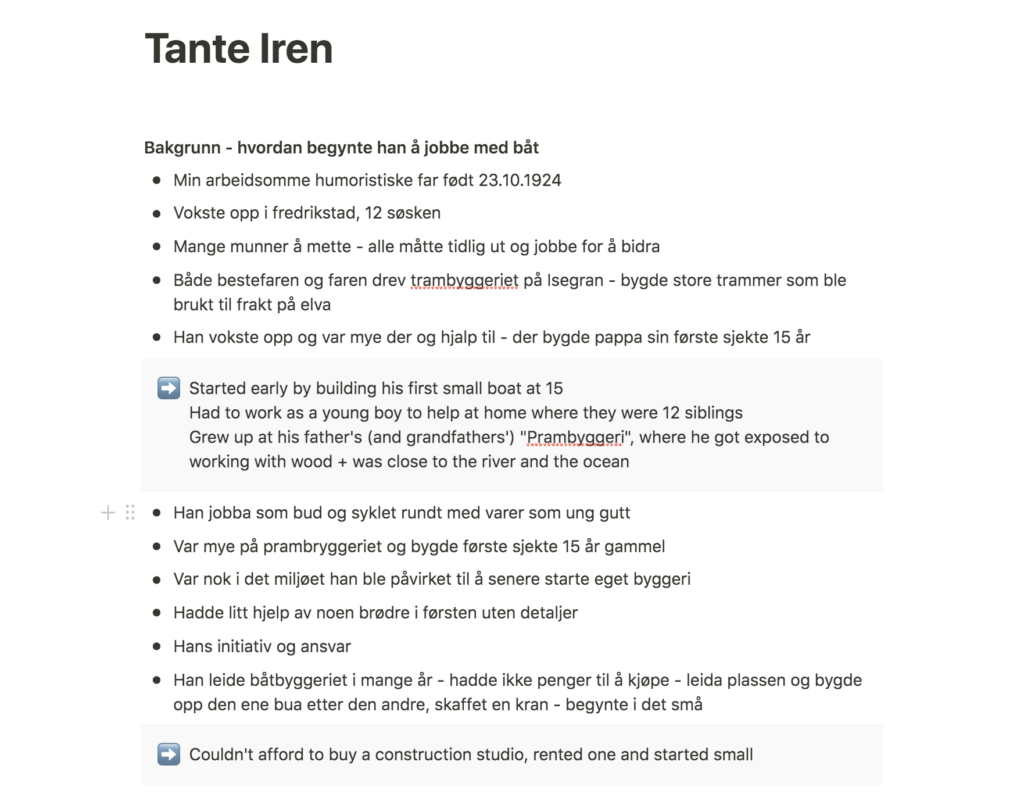
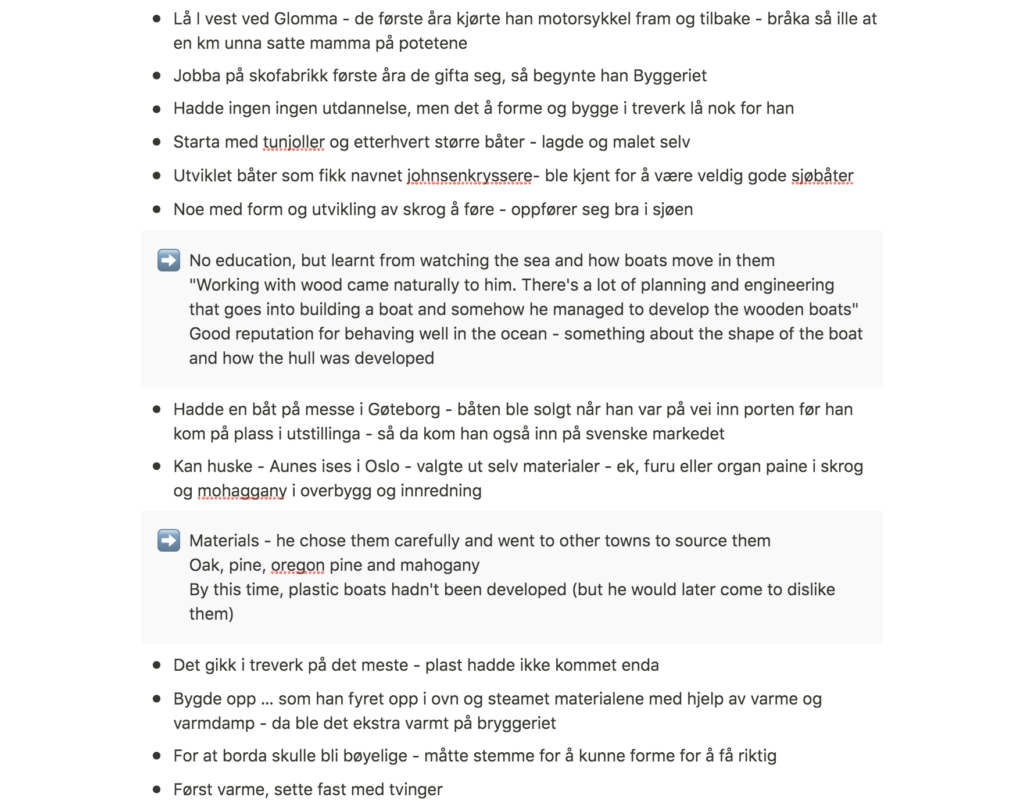
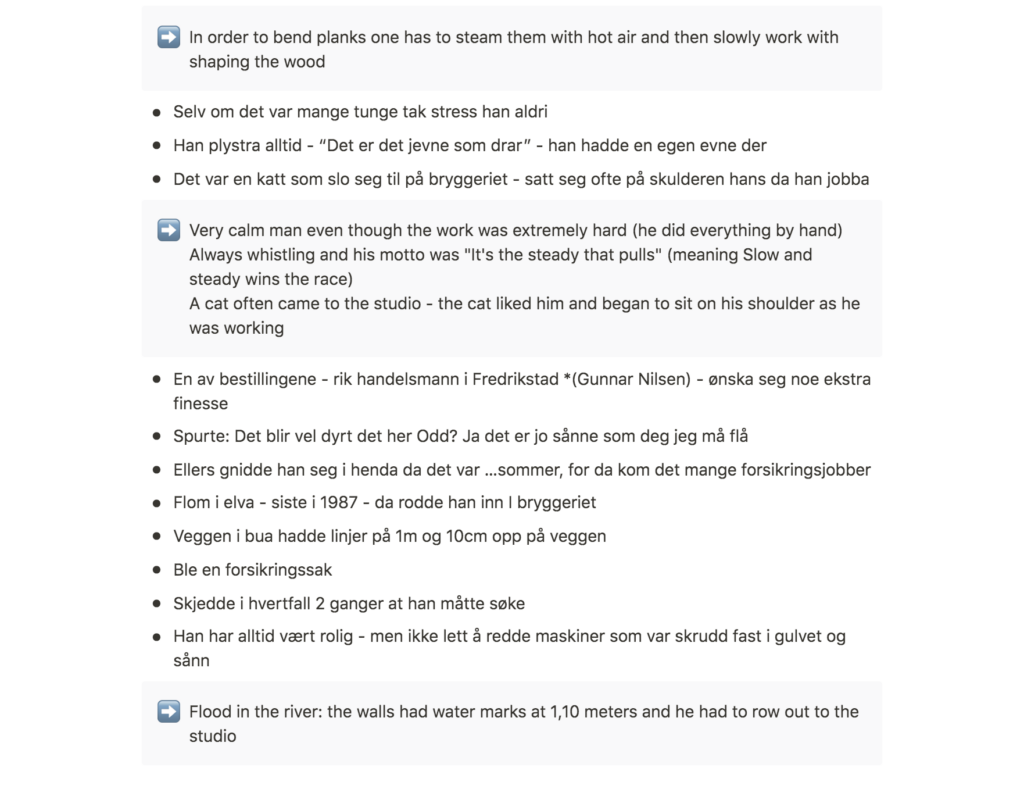

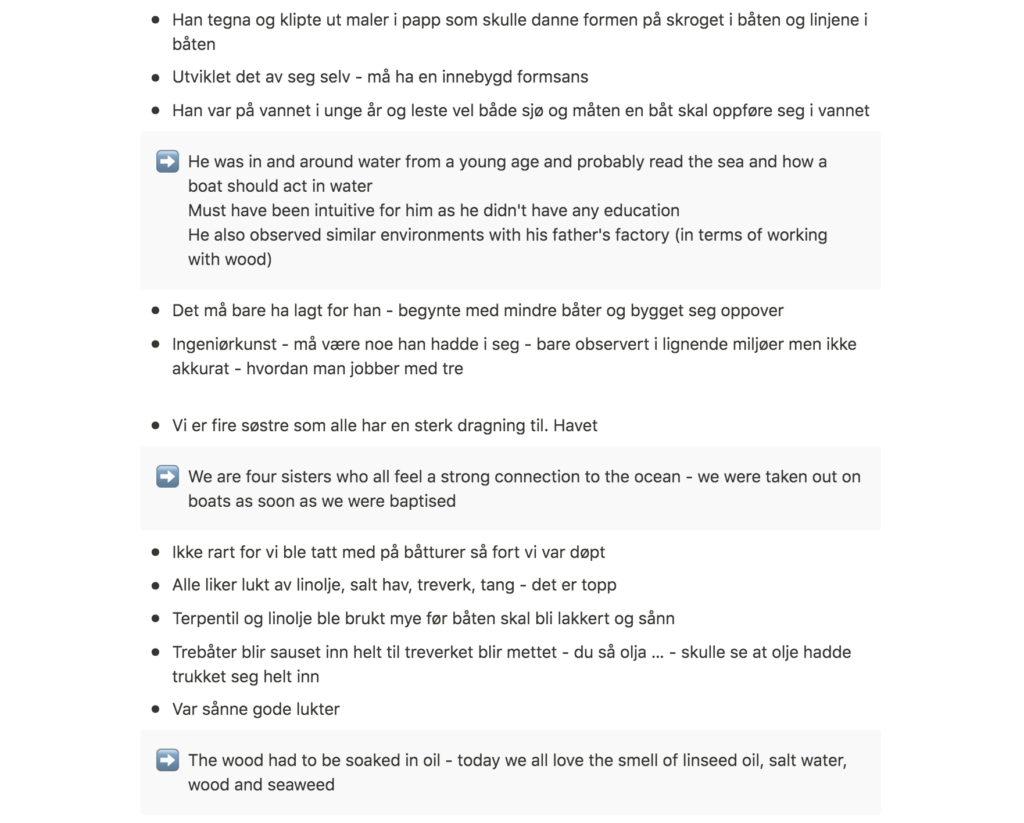
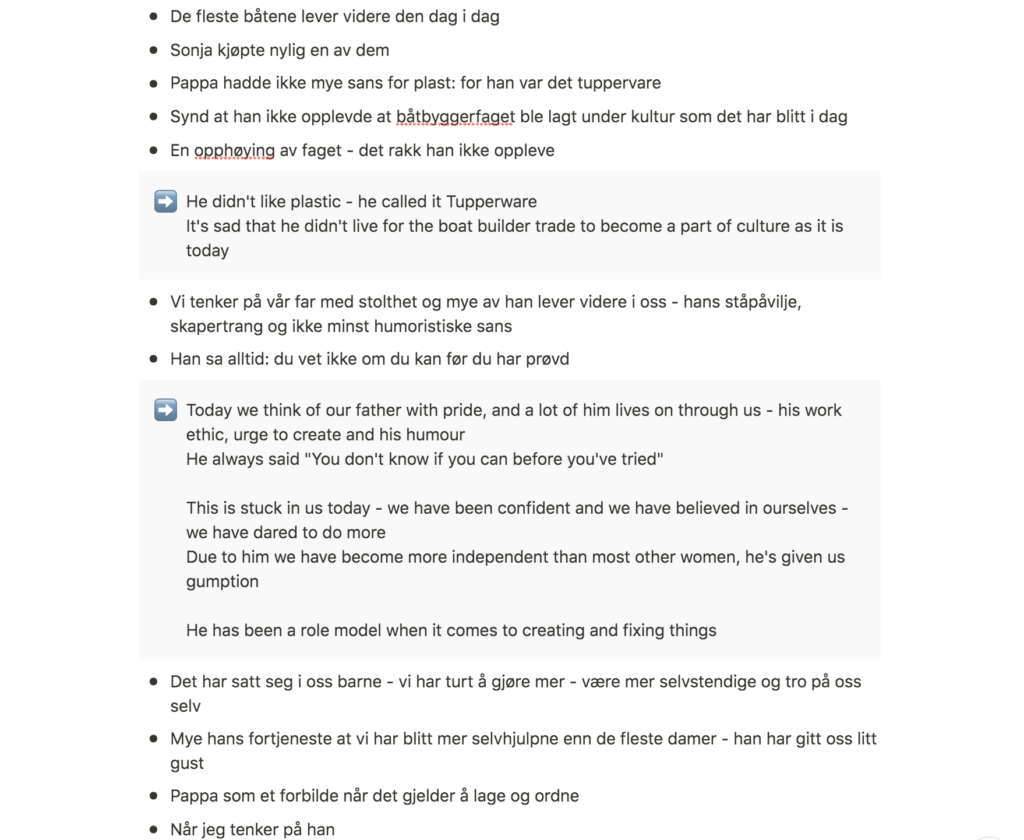

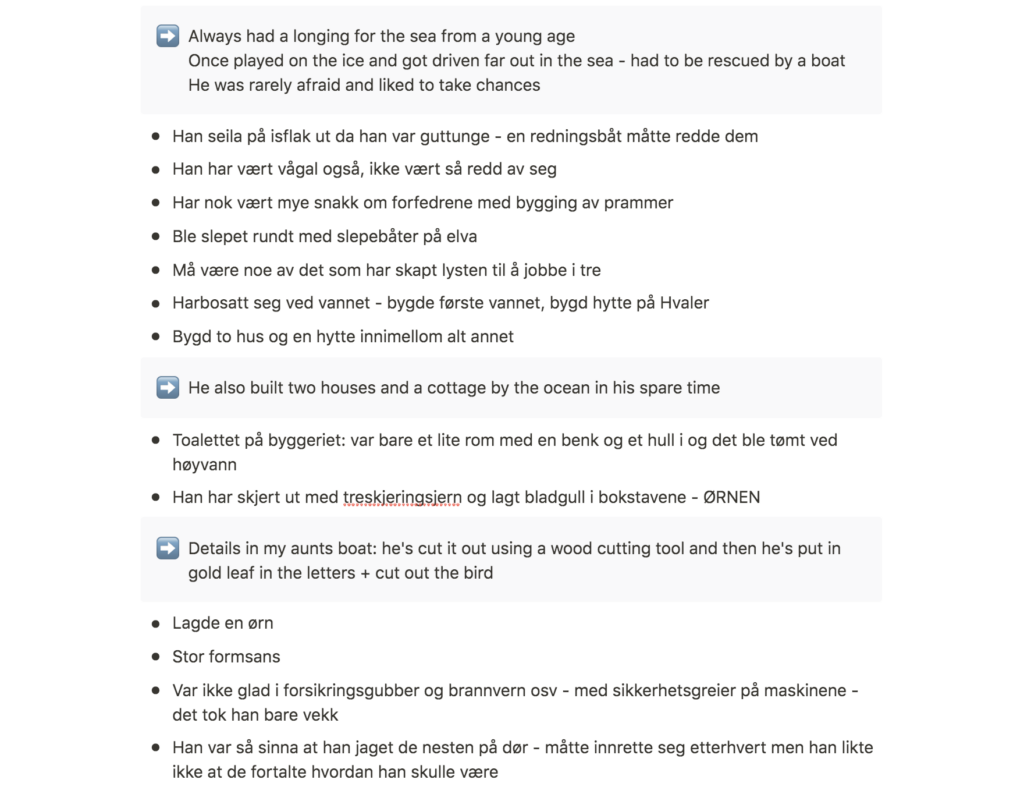
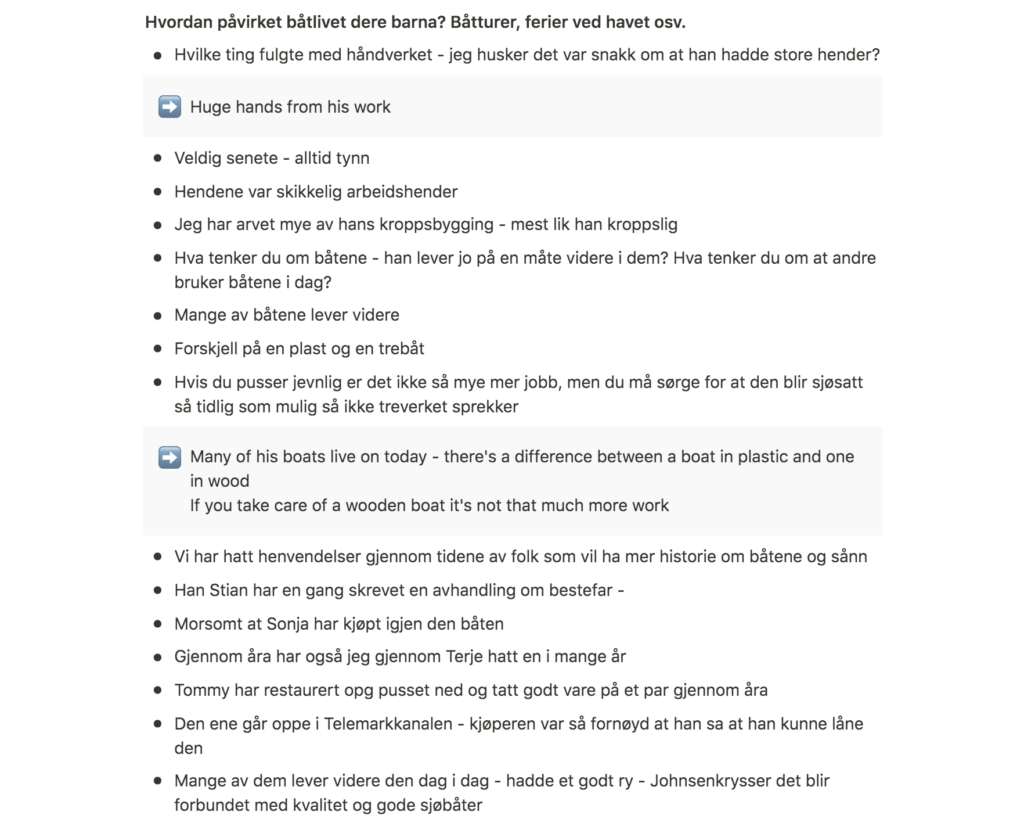

As my grandfather passed away when I was quite young, I don’t know too much about his boat building business. I therefor decided to have a semi structured interview with my aunt, who remembers a lot more, and who also have news paper articles and other documents which she checked for facts. I have tried to translate the most interesting findings in my notes above.
The interview made me reflect upon heredity and environment. My grandfather’s work ethic and visual ability has been passed down to my mother and her sisters, and I believe, also to me and my brother. So has the love for being close to the sea. Although it probably has a scientific reason (as most people do like being close to the ocean and working with something they love), I do like to think that there is almost a sort of spiritual connection between the generations of a family, which has given me creativity, work ethic and a love for the ocean.
I think a lot of the information from my interview could be used in an essay, but I still feel like I’m missing some visual information. It is quite hard to travel home (although it is a short trip) during Covid, but I will consider doing so over the next weeks, for visual material, old photographs, as well as new photographs of my aunt and my grandfather’s boats if I can find any. Inspired by the interview findings, I decided to create a small list of how creatives can learn from my grandfather’s way of being and working. This could perhaps spark the essay somehow.
What can I as a creative learn from my grandfather?
- Stay calm (“Slow and steady wins the race”)
- Observe (in order to learn, you need to understand how your product works in it’s environment)
- Make it work (if he can move an entire boat on his own, I can find solutions for my tiny problems)
- Help others, but stay true to your craft
Interview with a boat builder: Trond Birkeland
Although the interview with my aunt was great in terms of understanding more about my grandfather’s life and boats, I still didn’t feel like I had enough material on boat making and wooden boats as subject. Then I discovered an interview with one of Oslo’s few boat makers in D2, a Norwegian lifestyle magazine.
The nostalgic value of wooden boats
In the article, the journalist and Birkeland discusses the nostalgic value of wooden boats. It’s often packed with family memories and the boat is often a family treasure (John-Arne Ø. Gundersen, 2020). The main value of wooden boats is perhaps not of practical manners, but rather of feelings and our senses (John-Arne Ø. Gundersen, 2020). They move at a slow pace, make a rhythmic sound that we might associate with being calm and happy (John-Arne Ø. Gundersen, 2020).
An object to care for
Birkeland goes on to discuss how a wooden boat has to be taken care of if it is to last (John-Arne Ø. Gundersen, 2020). It has to be taken up to shore by a certain time and you need to coat it regularly (John-Arne Ø. Gundersen, 2020). If not, it will eventually start to leak (John-Arne Ø. Gundersen, 2020). However, he also says that by taking care of wooden boats, you can make them last forever (John-Arne Ø. Gundersen, 2020).
To think that the destiny of my grandfather’s boats lies in the hands of strangers is both interesting and worrying. If the owners care for the boats, they are in some way keeping the memory of him alive. If they neglect the boats, however, the memory might start to fade.
Ocean vs. wood – what is the focus?
After interviewing my aunt, it became clear that wooden material was an important part of my grandfater’s craft. Thus, I wonder wether it is vital to focus on the ocean or if should rather focus on hand made craftsmanship and how it lives on through my family’s generations (could I for example create a family tree which describes who has taken on a creative job and who has not – mapping the journey of craftsmanship?). However, I still think it could be interesting to look at how being close to water affects creativity. Further, I would be interested in experimenting with his craft (wood) and working near the sea. Could I for example visit the sea every day for a week, and track my creativity somehow? This way, the essay/publication could almost become a diary or report of an experiment where I attempt to follow my grandfather’s foot steps. I could also take a completely different direction where I focus on documenting the visual culture of my grandfather’s boat making studio, bringing old graphics and images to life in a visual publication.
Image
As mentioned in the concept 1 section, I didn’t have time to spend much time on the design process for my image, as I felt that I needed to prioritise the research this week. I did however do a little bit of sketching and experimenting for concept 2.
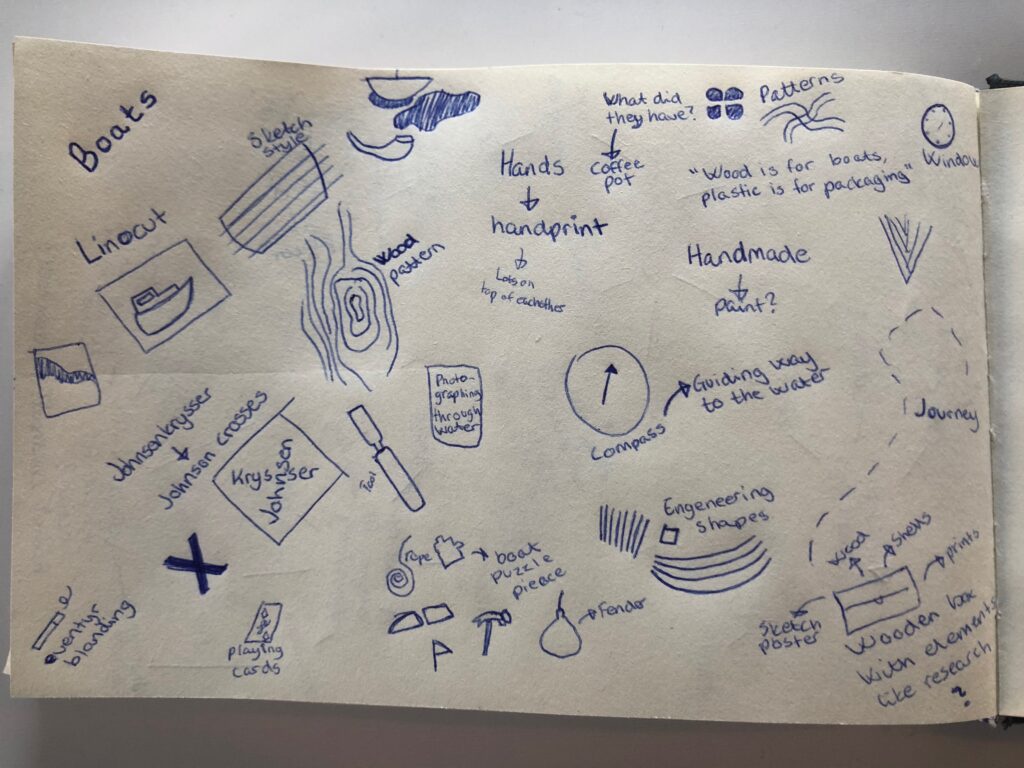
I wanted to incorporate the handcraft element of boat building, perhaps by including wood. I had the idea of attempting wood cutting and wood block printing, but unfortunately this was too ambitious within the set time frame. I also thought about playing on the name of the boats (Johnsonkrysser – Johnson crosser) by incorporating crosses. Further I considered experimenting with pace inspired by the calming sound of wooden boats.
The mockup used in this work was collected from a website with a creative commons license, and was not created by me.
I ended up with the image below as I thought that best represented the craft of boat building. Ideally I would have liked to create a sketch more in line with the shapes of a boat, but with time restrictions I decided to settle on this one. I also rotated the type to represent my grandfather’s humor.
If had managed to source more images and graphic material from my grandfather’s boat business this week, I would have loved to create a visual style in line with that material. If I am to continue with this project I think it is important to source such material and perhaps to visit my home town in order to photograph boats, people and perhaps talk to more of my family members. Further, I want to develop a more comprehensive idea through a detailed design process.
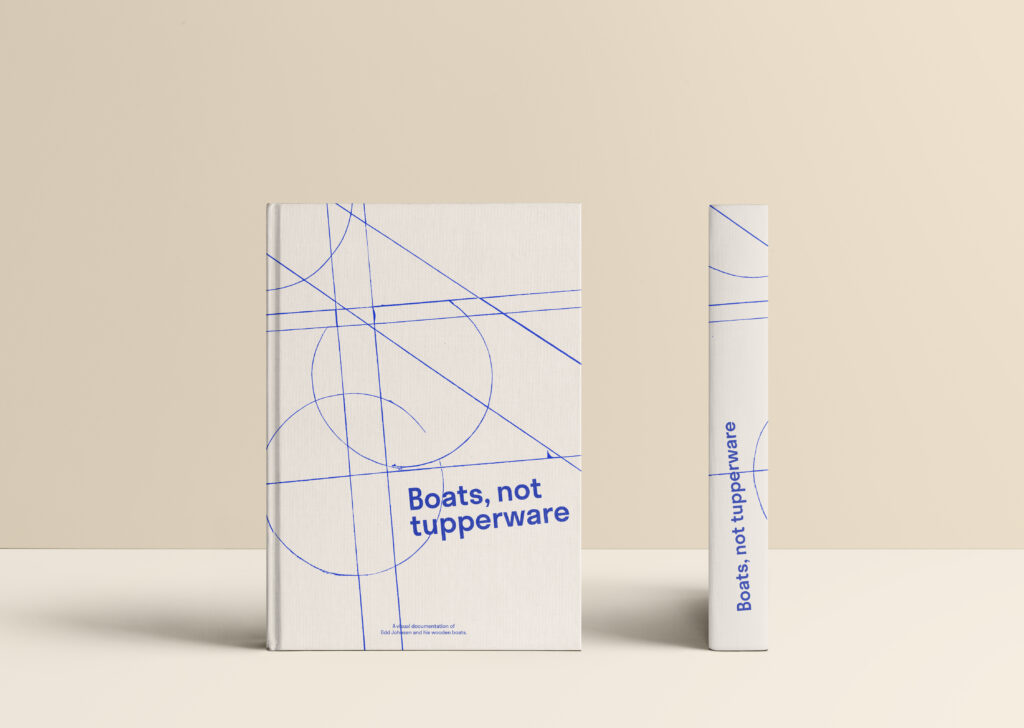
The mockup used in this work was collected from a website with a creative commons license, and was not created by me.
100 word synopsis
My grandfather was a boat builder and as a result my mom spent a lot of time by the sea growing up. This is something she passed on to me and my brother, and now that I live in a big city I feel a deep longing for the ocean. In this essay I will document the craftsmanship of my grandfather’s work by looking at his life and boat business. By doing so, I hope to analyse my connection to the sea through him, but perhaps also our correlating choice of a visual profession. My aim is to tell the story of my grandfather’s life (whilst connecting his story to my own), but also to analyse the nostalgic essence of wooden boats and the rhythmic and sense oriented experience they provide.
Final PDF
The mockup used in this work was collected from a website with a creative commons license, and was not created by me.
In conclusion
This week has been interesting as it is the first of the course where I’ve spent most of my time researching. It was lovely to delve into a variety of material, although slightly overwhelming in terms of finding people to interview. After researching into my two ideas I have become quite pleased with them and I can see both becoming interesting projects.
For the collection project I wish I had been able to collect more interviews with collectors. The fact that I struggled with finding people makes me wonder if I will be able to pursue the project in a comprehensive manner. I do see this concept as very photo driven and I would like to portray the collections in a way that makes the reader appreciate them. This might become slightly difficult due to Covid restrictions.
Further, I wish I would have been able to collect more photographs and news articles for my second concept. If I am to pursue this direction for my essay I will have to figure out a way of sourcing it. At the moment I am leaning towards concept two, as the it feels both personal and fascinating. The project would provide an opportunity to get to know my grandfather in a new way, though his craft and work ethic. I also think the wood craftsmanship would make for some lovely visual explorations.
Although I think I’ve made the right decision when choosing to focus on research this week, I do wish I would have had more time with the visual process. I think the images are okay, but I would have liked to work further with ideas and production methods in order to create complete visual concepts. Hopefully I will be able to explore the project visually as I begin to write parts of my essay and as I get a clearer idea of my final written concept.
REFERENCES:
Bjørg Aftret and Hilde Marie Tvedten (2017) ‘Jan Roger samler på brudekjoler. I dag har han 378 av dem’, Dagbladet [online], 5 October. Available at: https://www.dagbladet.no/magasinet/jan-roger-samler-pa-brudekjoler-i-dag-har-han-378-av-dem/68748848 (Accessed: 2 March 2021).
Colin Robson (2002) Real world research: A resource for social scientists and practitioner researchers. Oxford: Blackwell Publishers.
Gule Sider (2016) Gule sider – Jeg møblerer Grünerløkka. Oslo. Available at: https://www.youtube.com/watch?v=sS787Jg78Jk&ab_channel=GuleSider (Accessed: 2 March 2021).
Irma Boom (2016) Irma Boom: A Tribute to Coco Chanel. Louisiana Channel. Available at: https://vimeo.com/142852186 (Accessed: 28 February 2021).
John-Arne Ø. Gundersen (2020) ‘Mesteren og mahogni’, D2, 24 July, pp. 36–43. Karin Madshus (2021) ‘Sjekk sportskommentatorens unike samling’, Vi.no, 24 January. Available at: https://www.vi.no/okonomi/sjekk-sportskommentatorens-unike-samling/73307626 (Accessed: 2 March 2021).
Munch museet (2020) ‘Samlingen’, Munch museet. Available at: https://www.munchmuseet.no/samlingen/ (Accessed: 2 March 2021).
Shweta Venkatramani (2018) ‘Why we are so attracted to the Ocean’, Medium, 10 January. Available at: https://medium.com/advensure/why-we-are-so-attracted-to-the-ocean-6d778ad65a41 (Accessed: 2 March 2021).
Stuart Tolley and Andrew Sanigar (2021) ‘Research and Curate’. Canvas Falmouth Flexible [online], 26 February.
LIST OF FIGURES:
Figure 1. Irma BOOM. 2013. A Tribute to Coco Channel. Divercity [online]. Available at: http://cargocollective.com/divercity/N-5-CULTURE-CHANEL-exhibition
Figure 2. Jean-Louis FROMENT. 2013. N°5 Culture Chanel. Divercity [online]. Available at: http://cargocollective.com/divercity/N-5-CULTURE-CHANEL-exhibition
Figure 3. Greger Ulf NILSON and Anders BERGESEN. 2020. The War Paint Box. Grafill [online]. Available at: https://www.grafill.no/avb/vinnere/2020/artists-books/artists-books/the-war-paint-box
Figure 4. NORTHING. 2019. MINI ZINE in NORWAY. Northing [online]. Available at: https://www.northing.no/minizineinnorway
Figure 5. Alex ASENSI. 2019. MINI ZINE in NORWAY. Grafill [online]. Available at: https://www.grafill.no/utstilling/kalender/utstillingsapning-norwegian-mini-zines
Figure 6. Kristine WATHNE. 2017. Jan Roger samler på brudekjoler. Dagbladet [online]. Available at: https://www.dagbladet.no/magasinet/jan-roger-samler-pa-brudekjoler-i-dag-har-han-378-av-dem/68748848
Figure 7. Unknown maker. 2021. No title. [coloured photograph]. Vi.no [online]. Available at: https://www.vi.no/okonomi/sjekk-sportskommentatorens-unike-samling/73307626 [accessed 4 March 2021].
Figure 8. Antonio Luìs CAMPOS. Ca. 2010-2020. Conserving paintings. Munch Museet [online]. Available at: https://www.munchmuseet.no/om-oss/konservering/
Figure 9. Unknown maker. 2016. No title. [book cover]. Tanum [online]. Available at: https://www.tanum.no/_min-historie-jens-stoltenberg-9788205483873 [accessed 4 March 2021].
Figure 10. GULE SIDER. 2016. Jeg møblerer Grünerløkka. Youtube [online]. Available at: https://www.youtube.com/watch?v=sS787Jg78Jk&ab_channel=GuleSider
Figure 11-13: Ingrid REIGSTAD. 2021. Collections. Private collection: Ingrid Reigstad.
Figure 14-15. Sonja HOVLAND. 2020. Ørnen. Facebook [online]. Available at: https://www.facebook.com/groups/1526354747509967
Figure 16. COMMON WORKS. 2018. Pictures of the floating world. It’s Nice That [online]. Available at: https://www.itsnicethat.com/news/common-works-somerset-house-film-251018
Figure 17-20: Ingrid REIGSTAD. 2021. Boat experimentation. Private collection: Ingrid Reigstad.
Figure 21: Ingrid REIGSTAD. 2021. Boats, not tupperware. Private collection: Ingrid Reigstad.
Figure 22: Ingrid REIGSTAD. 2021. Final PDF week 6. Private collection: Ingrid Reigstad.
